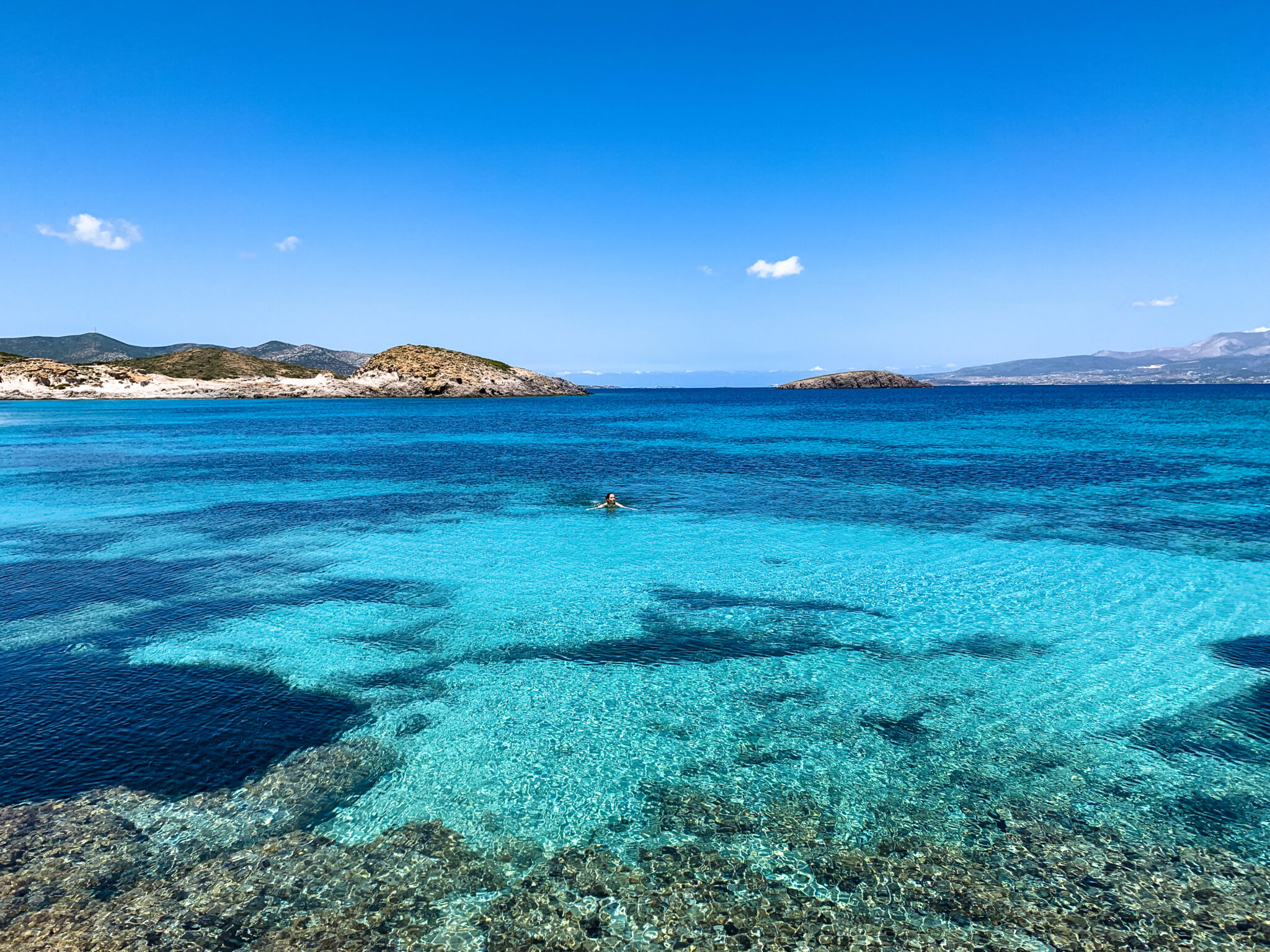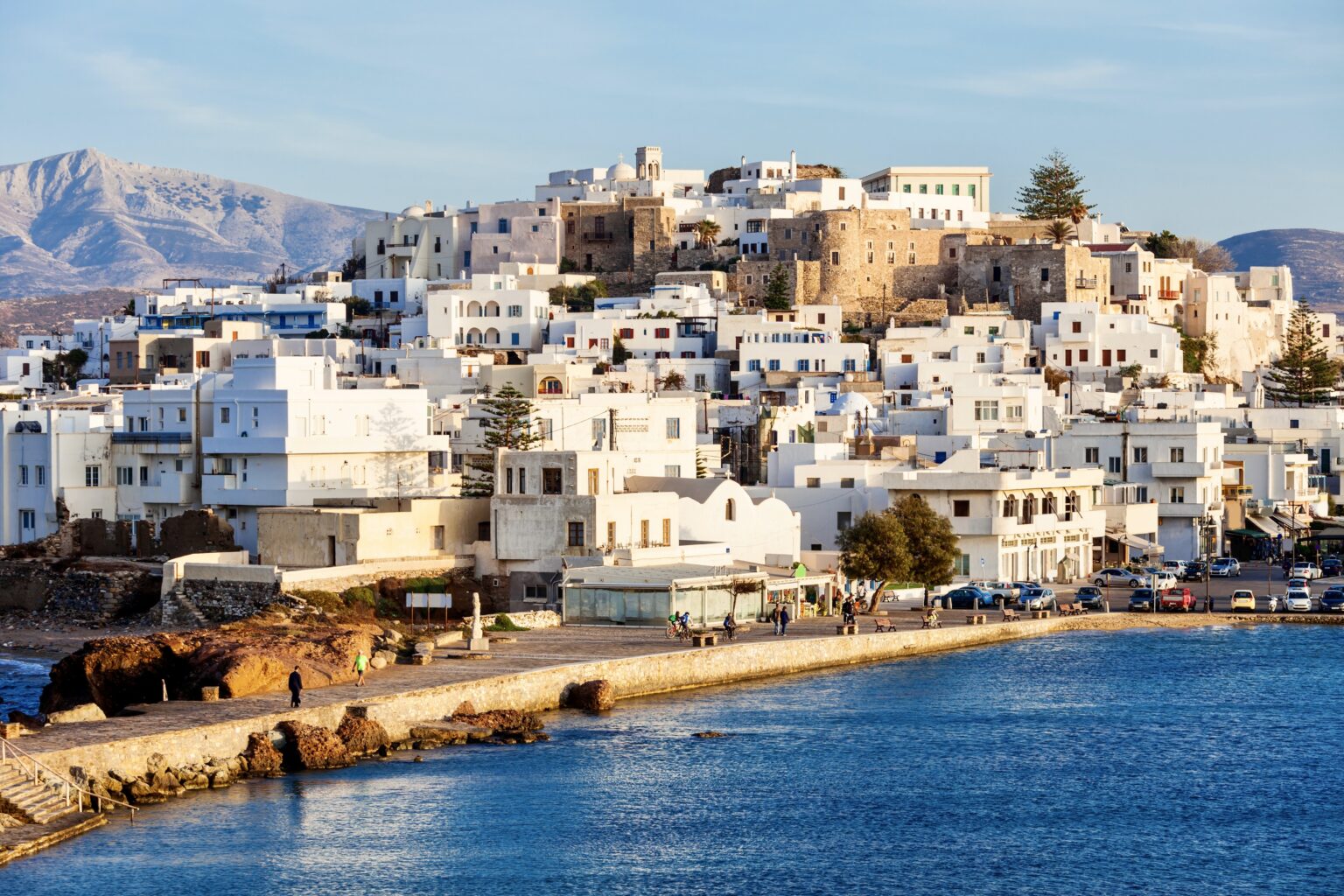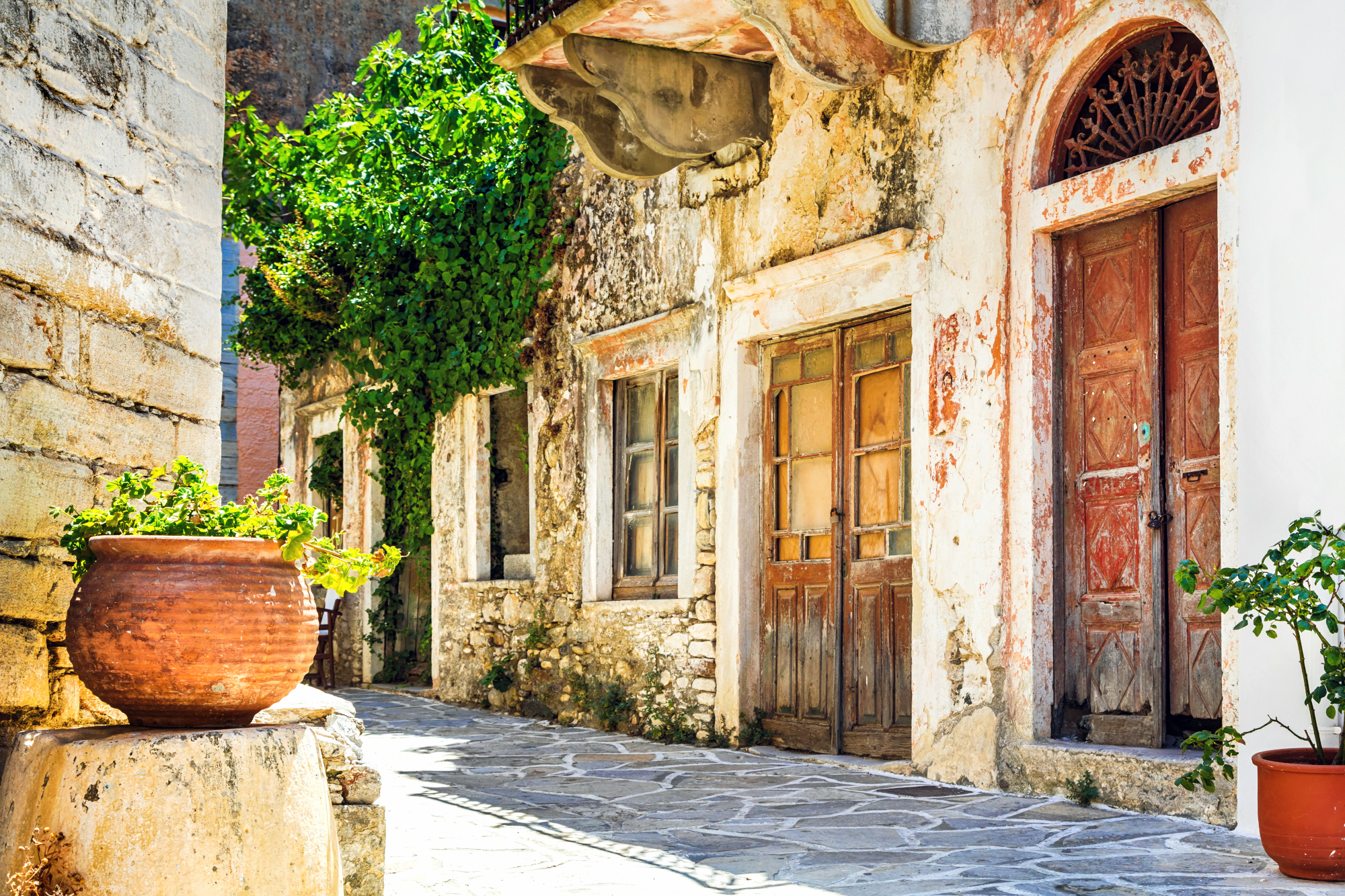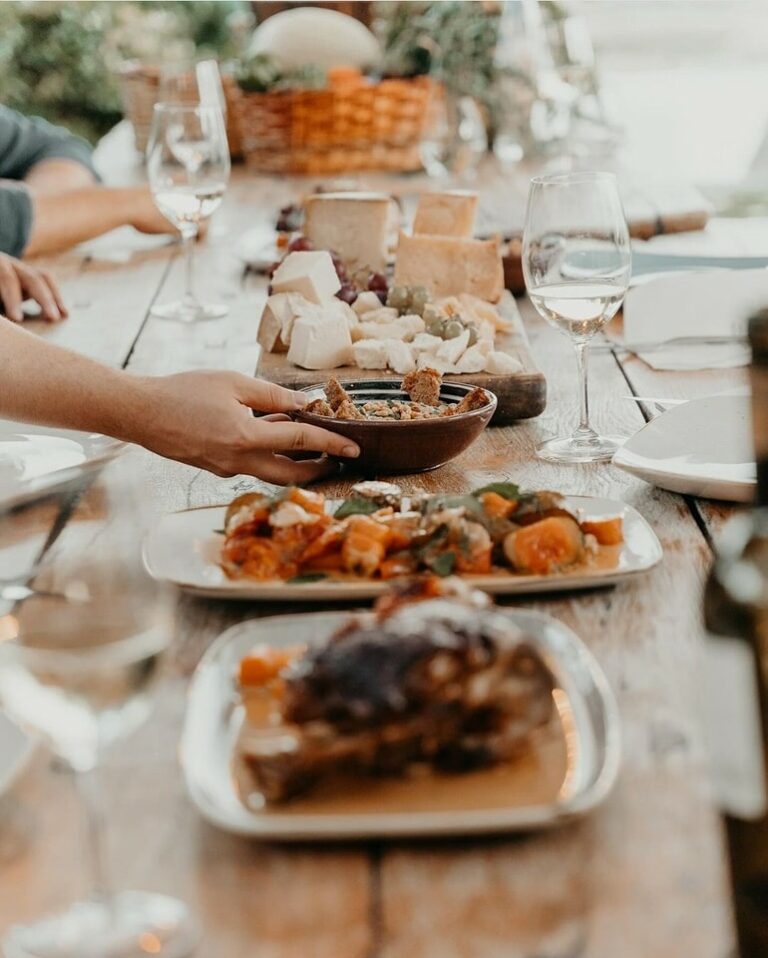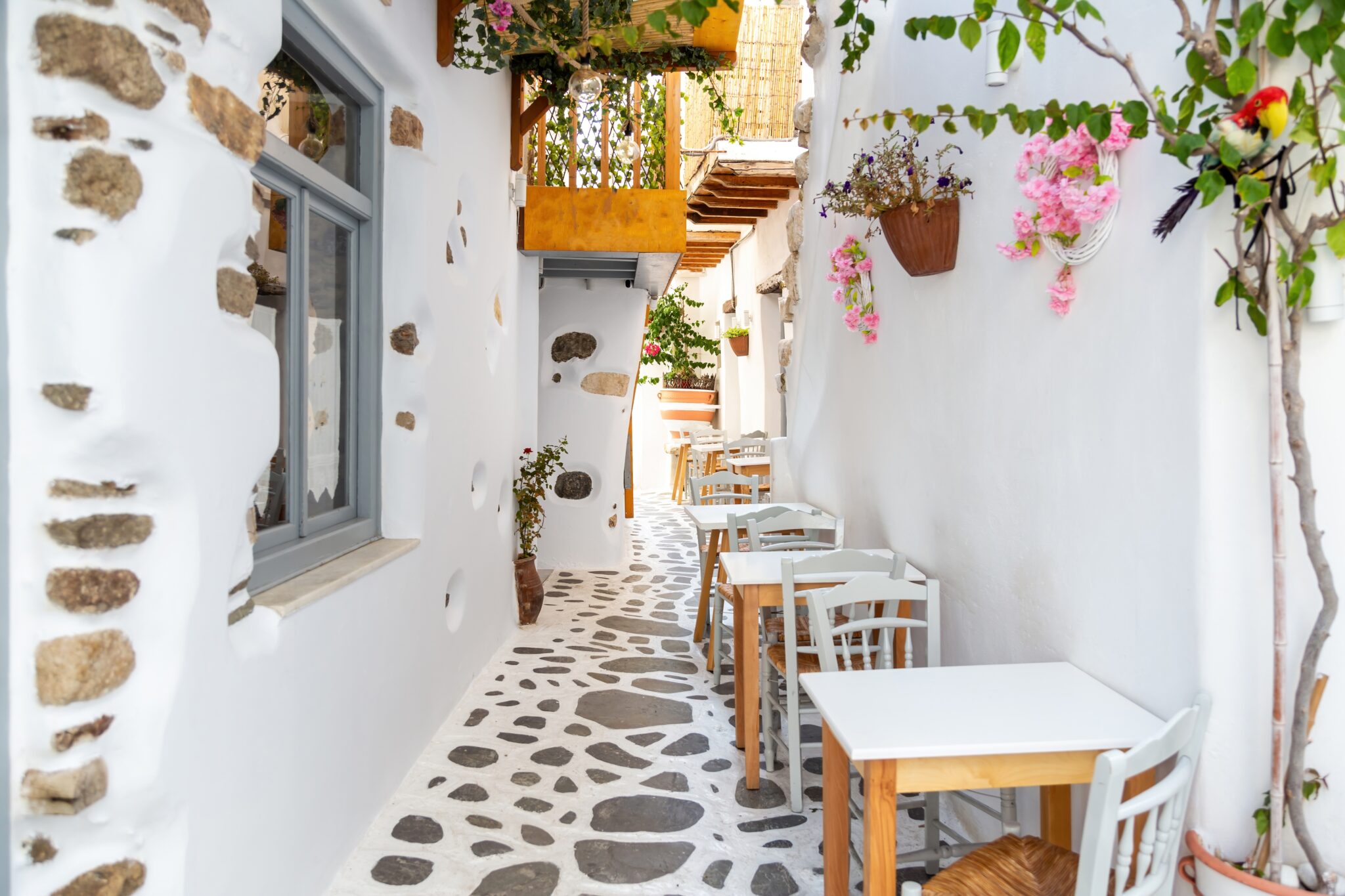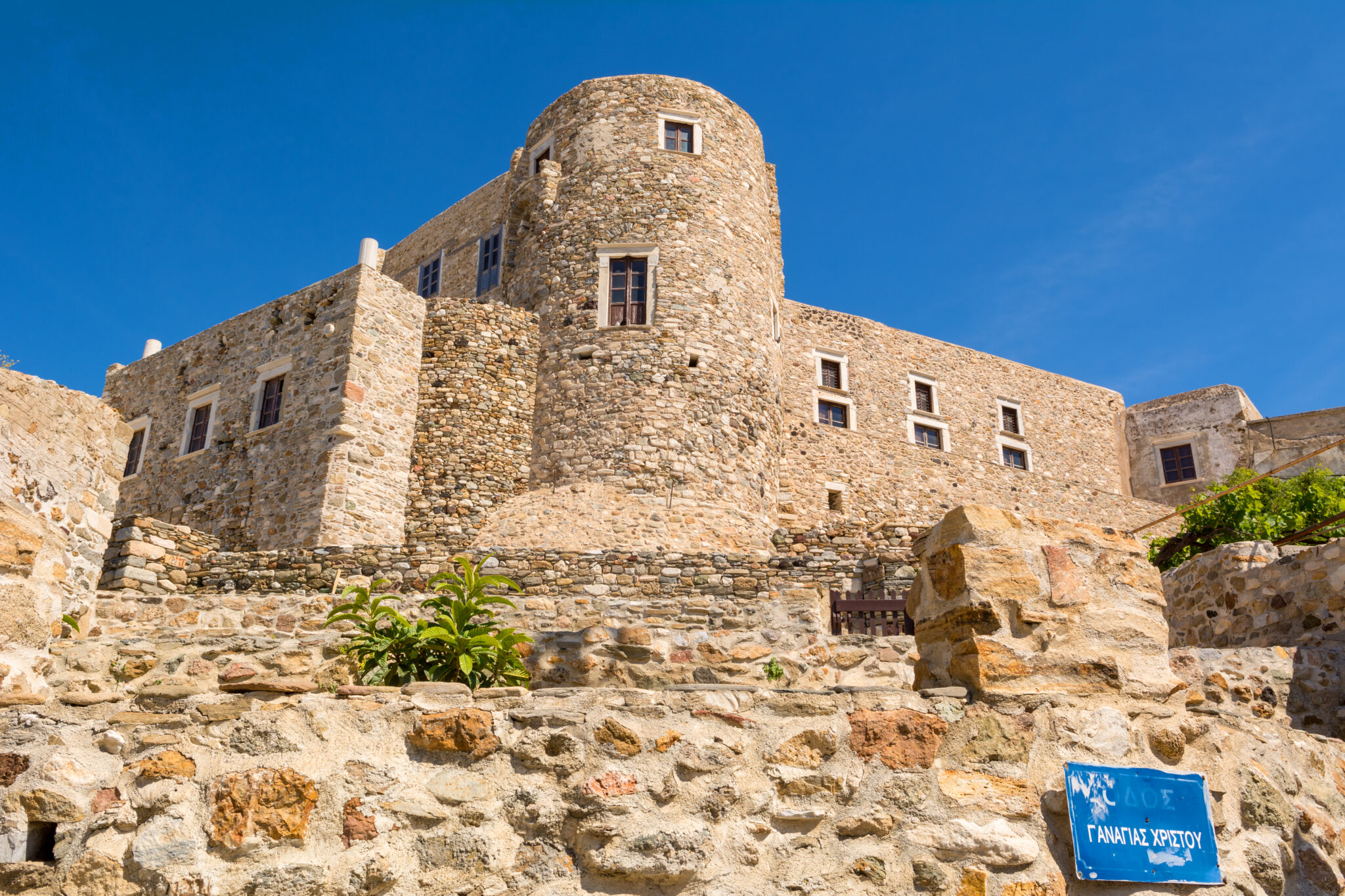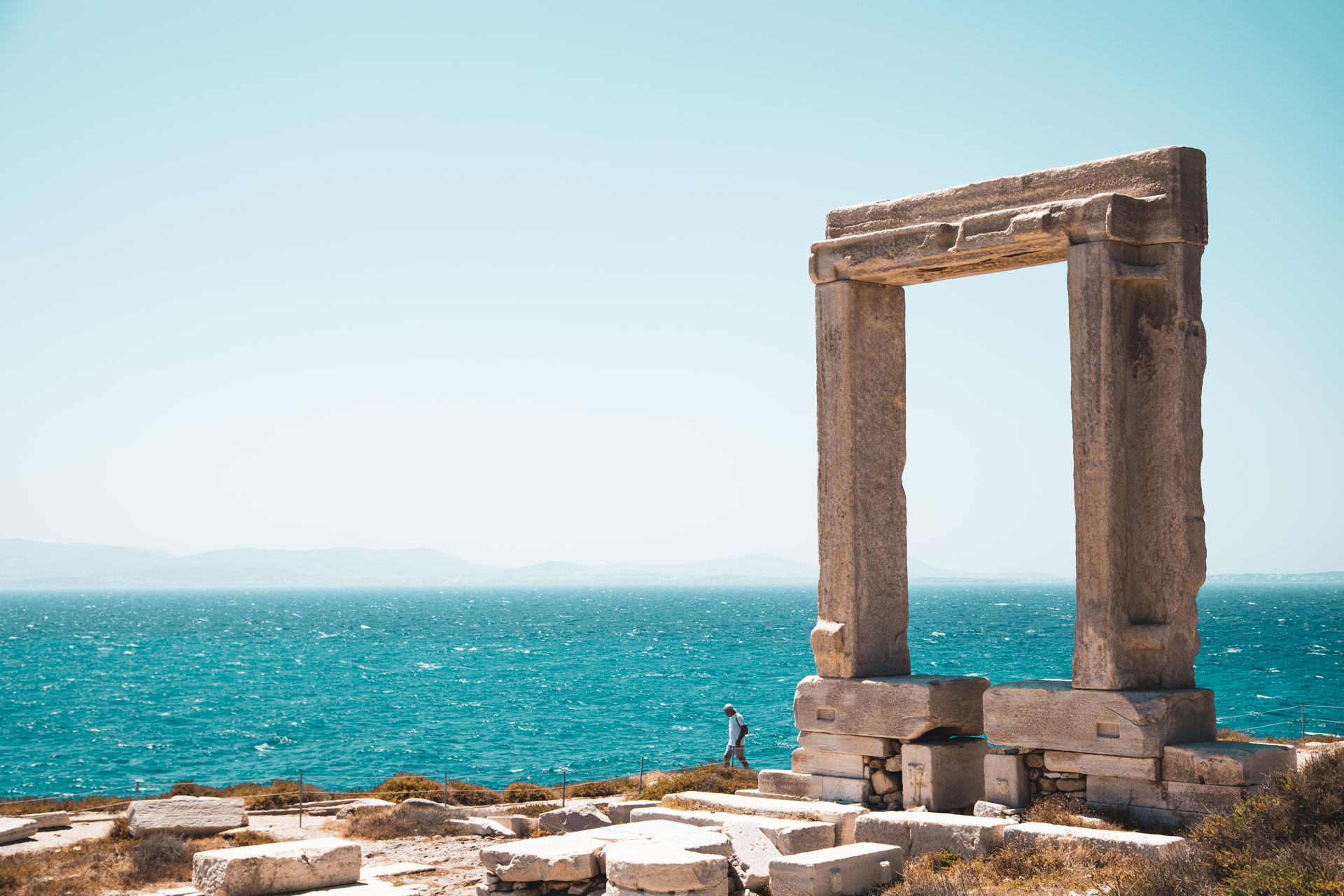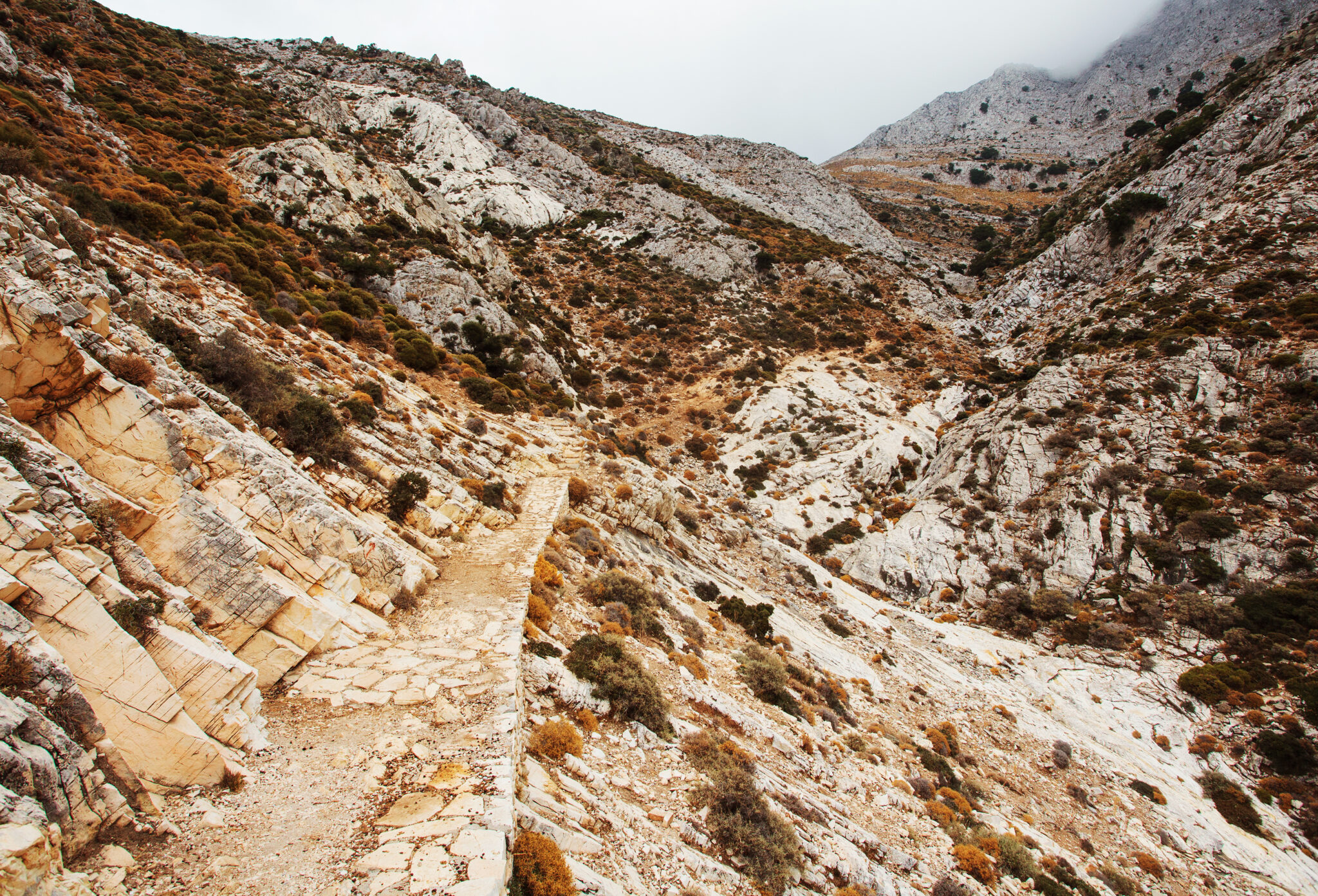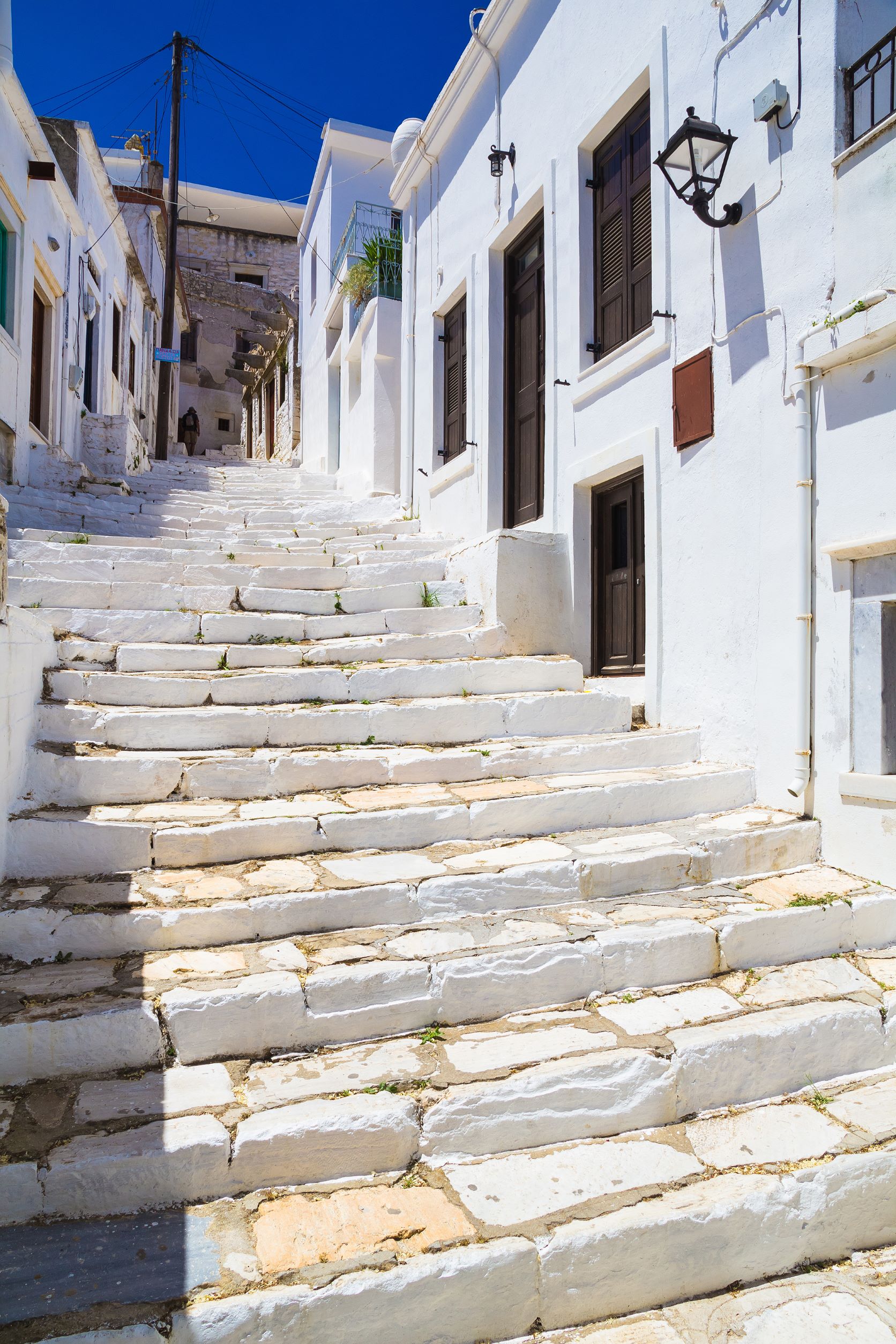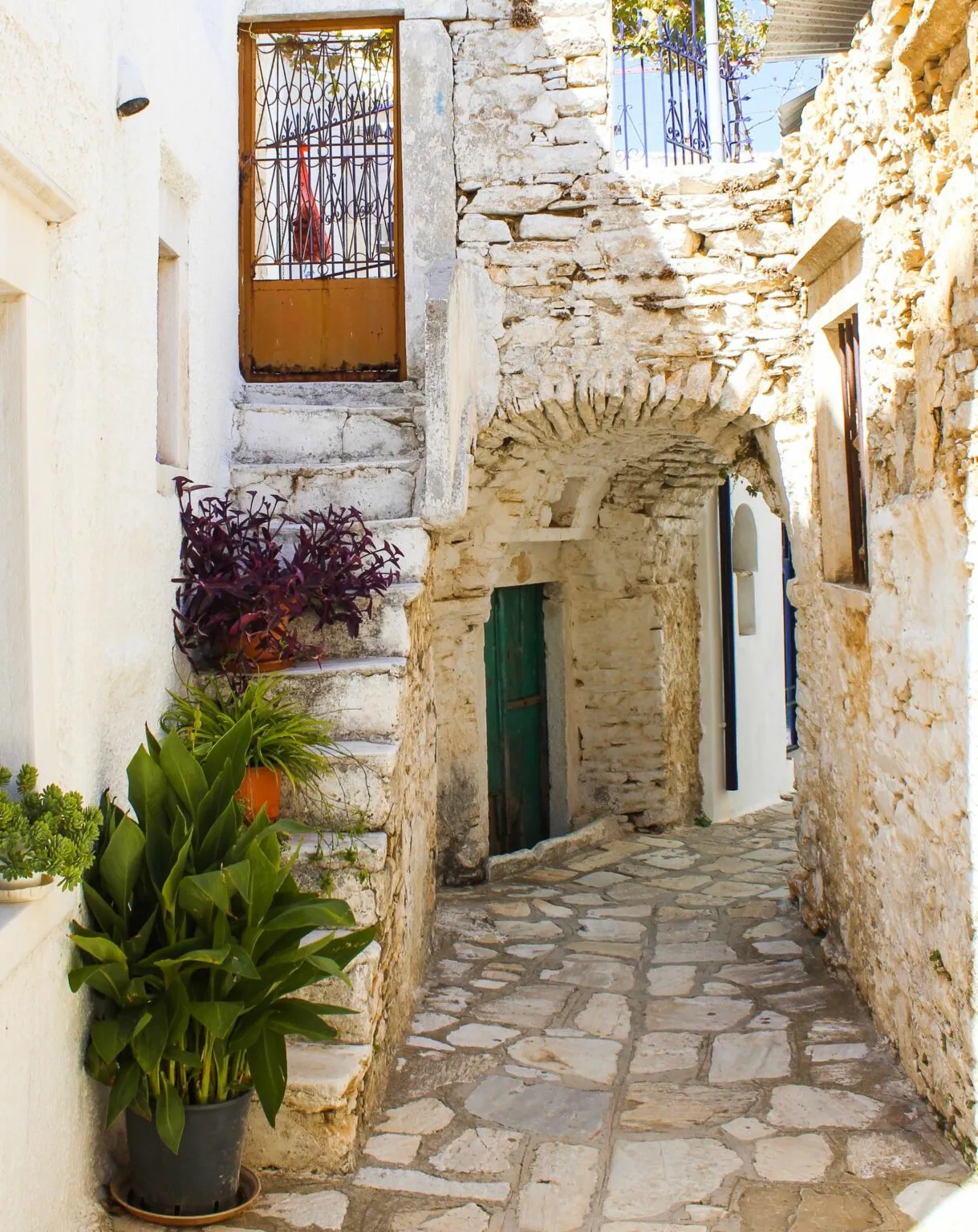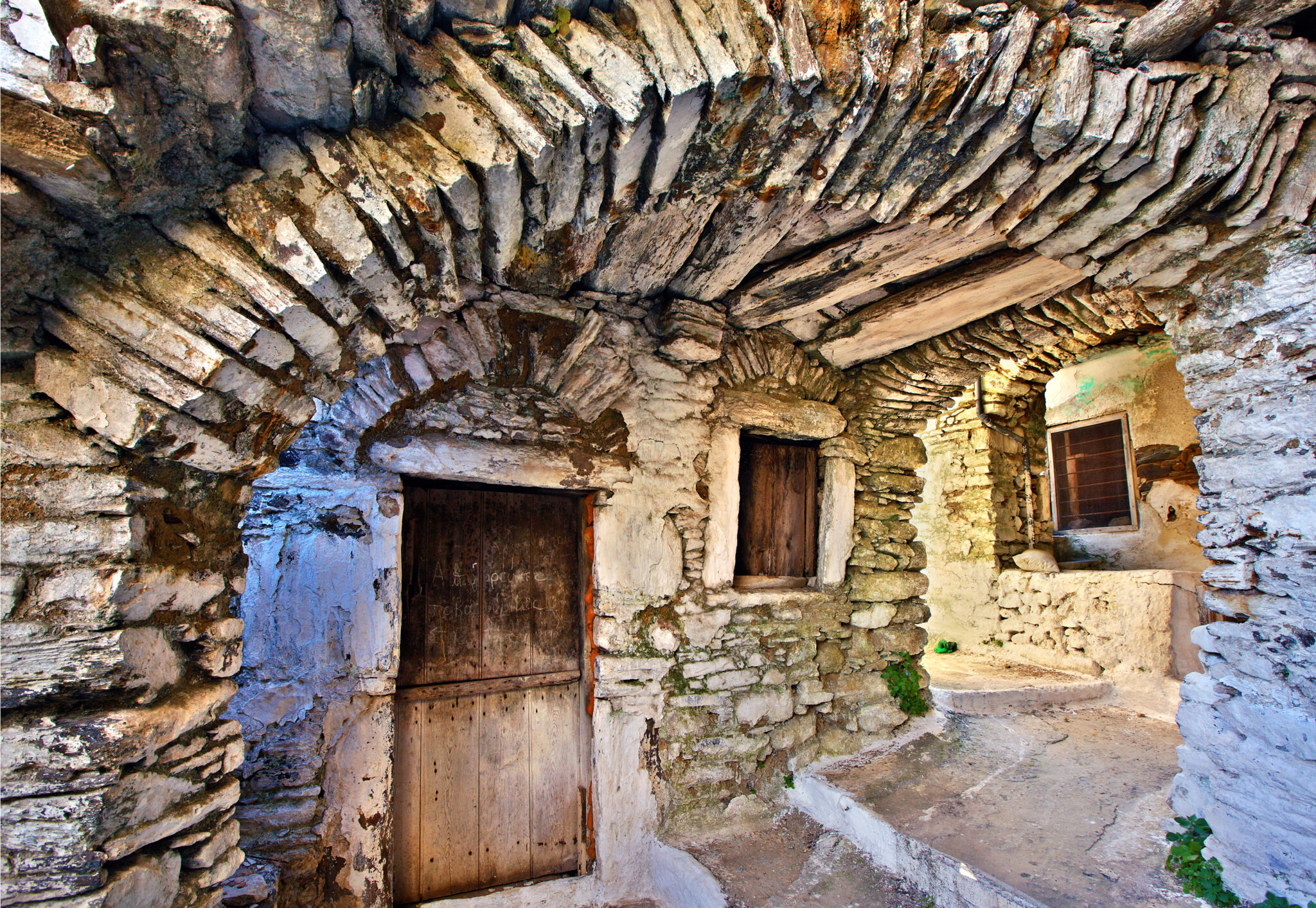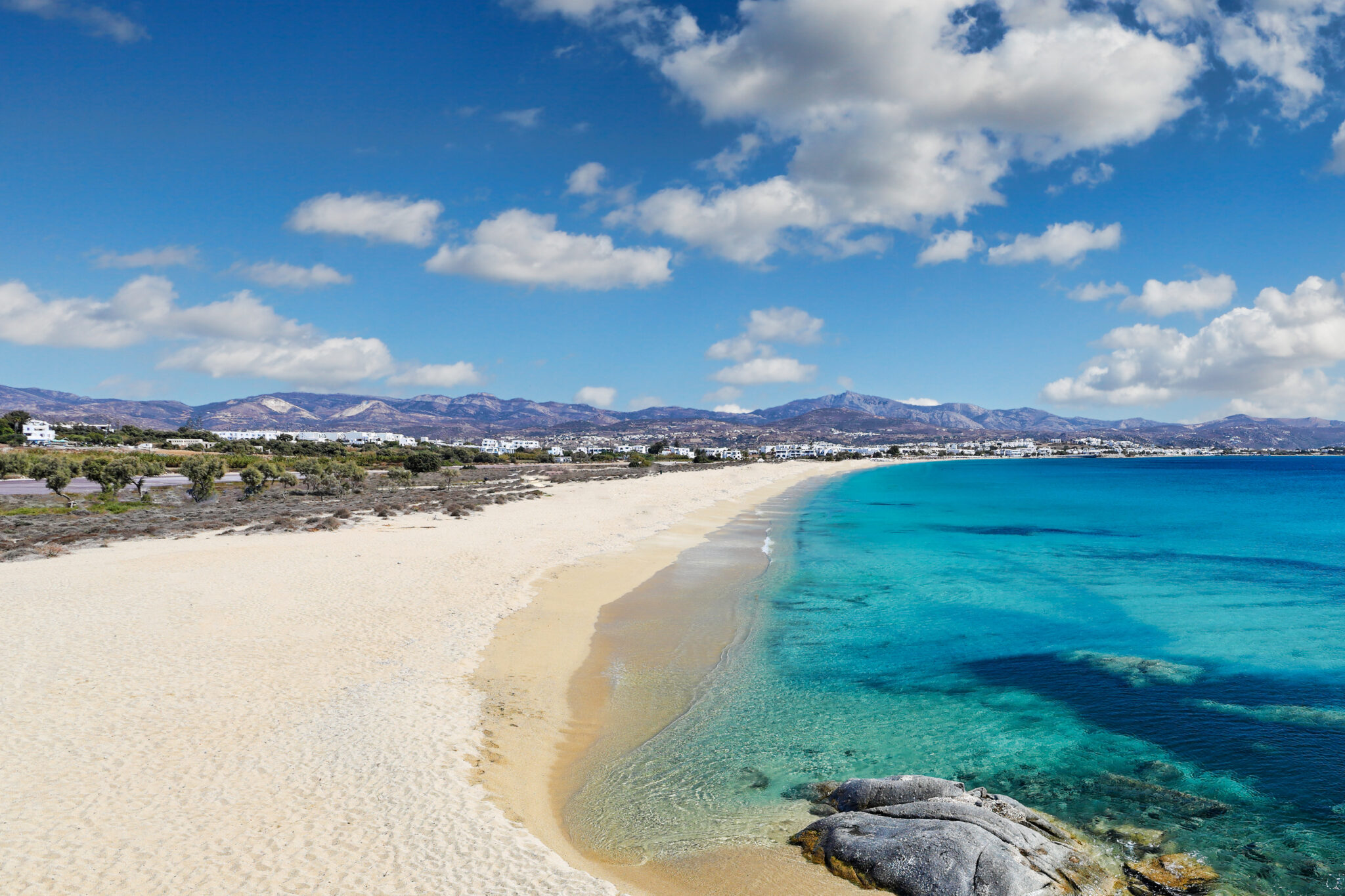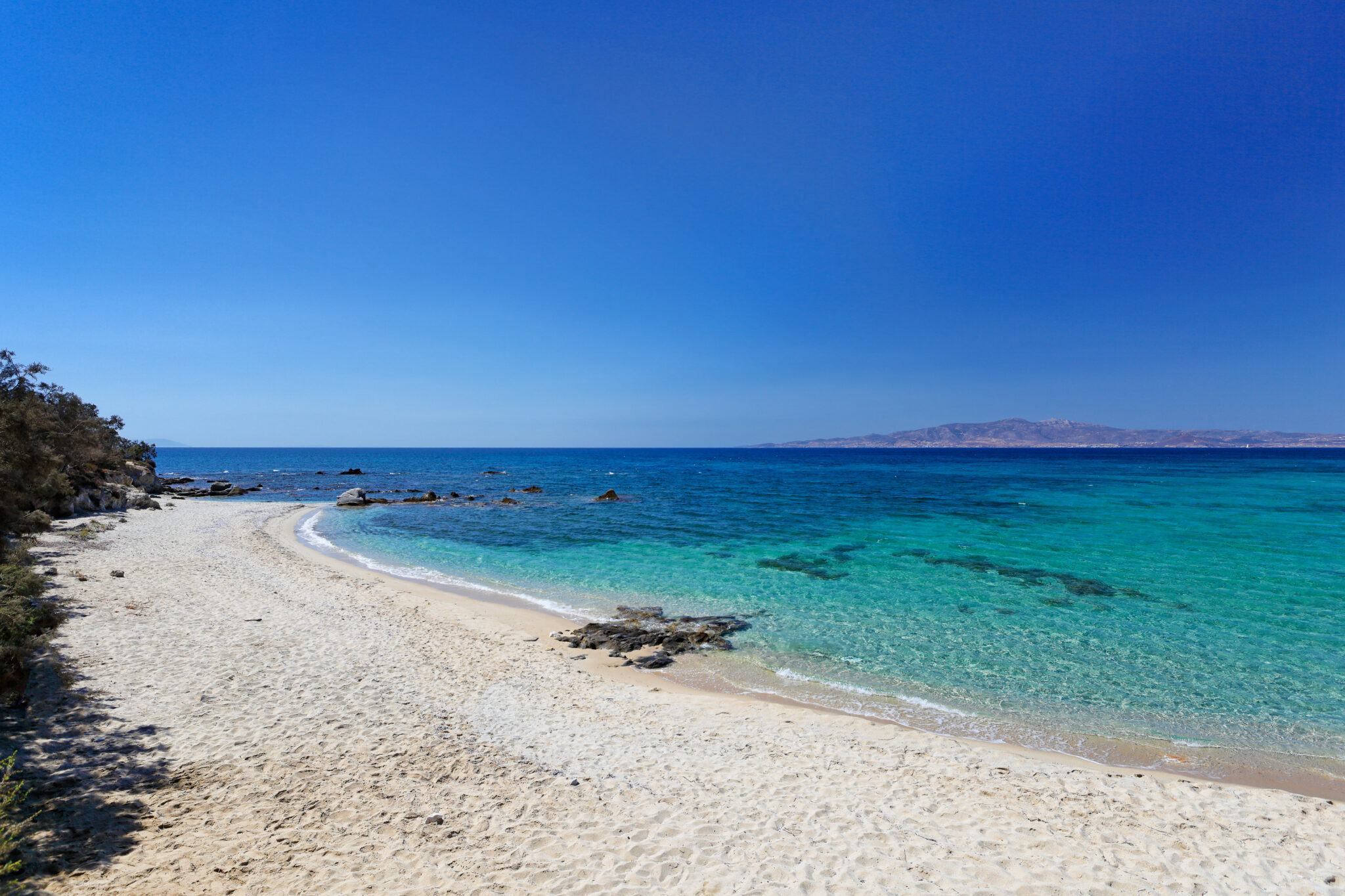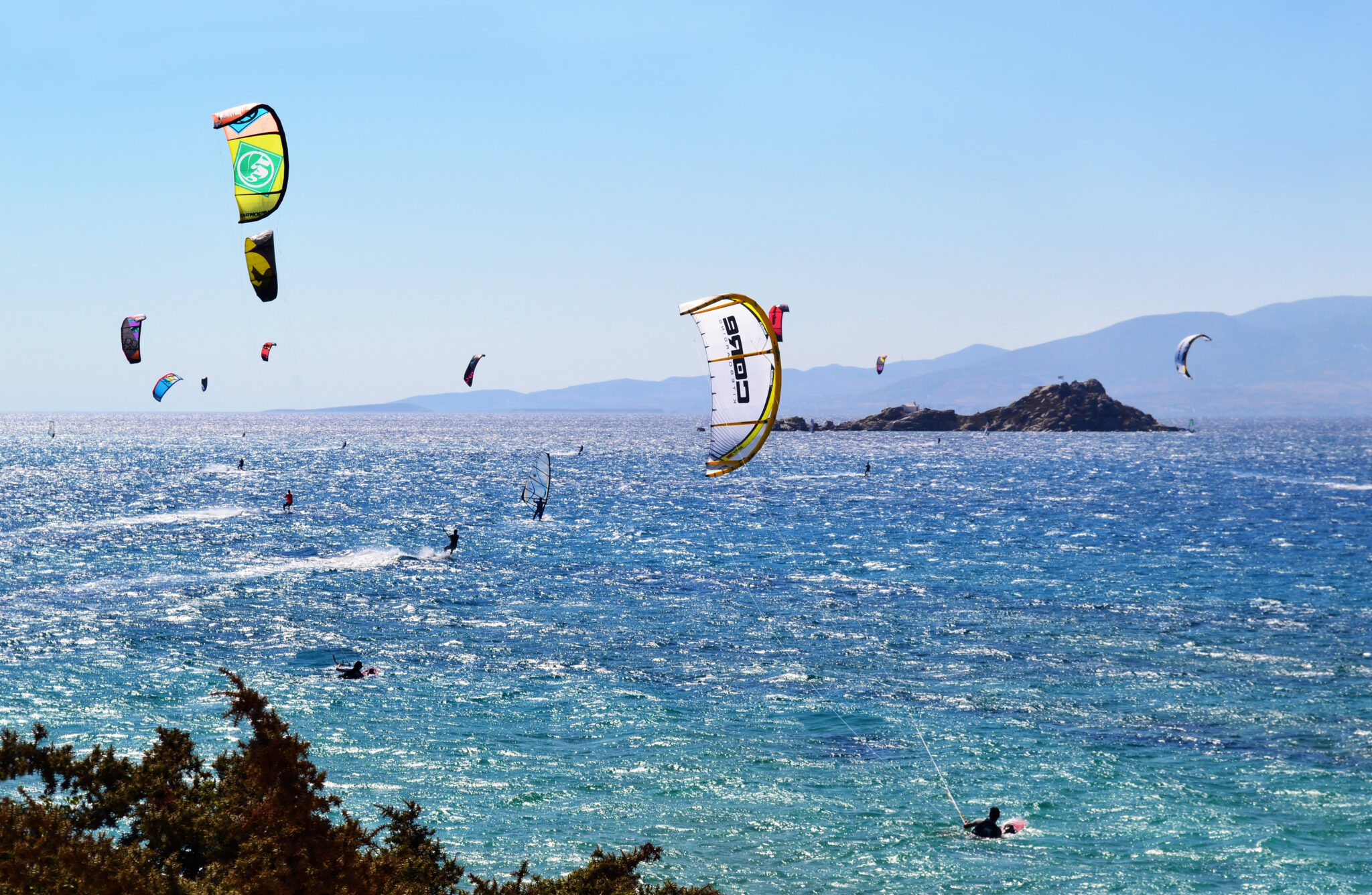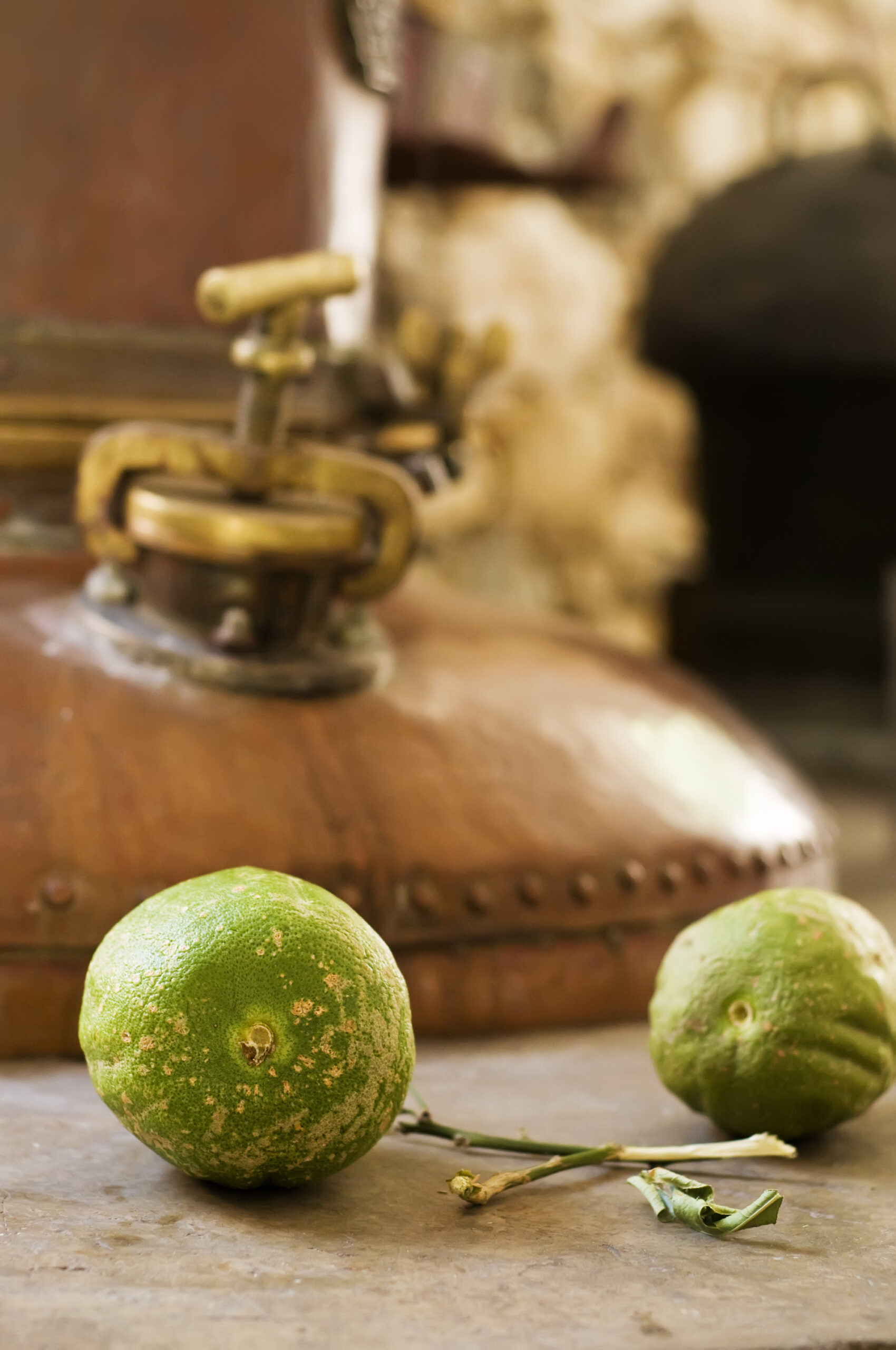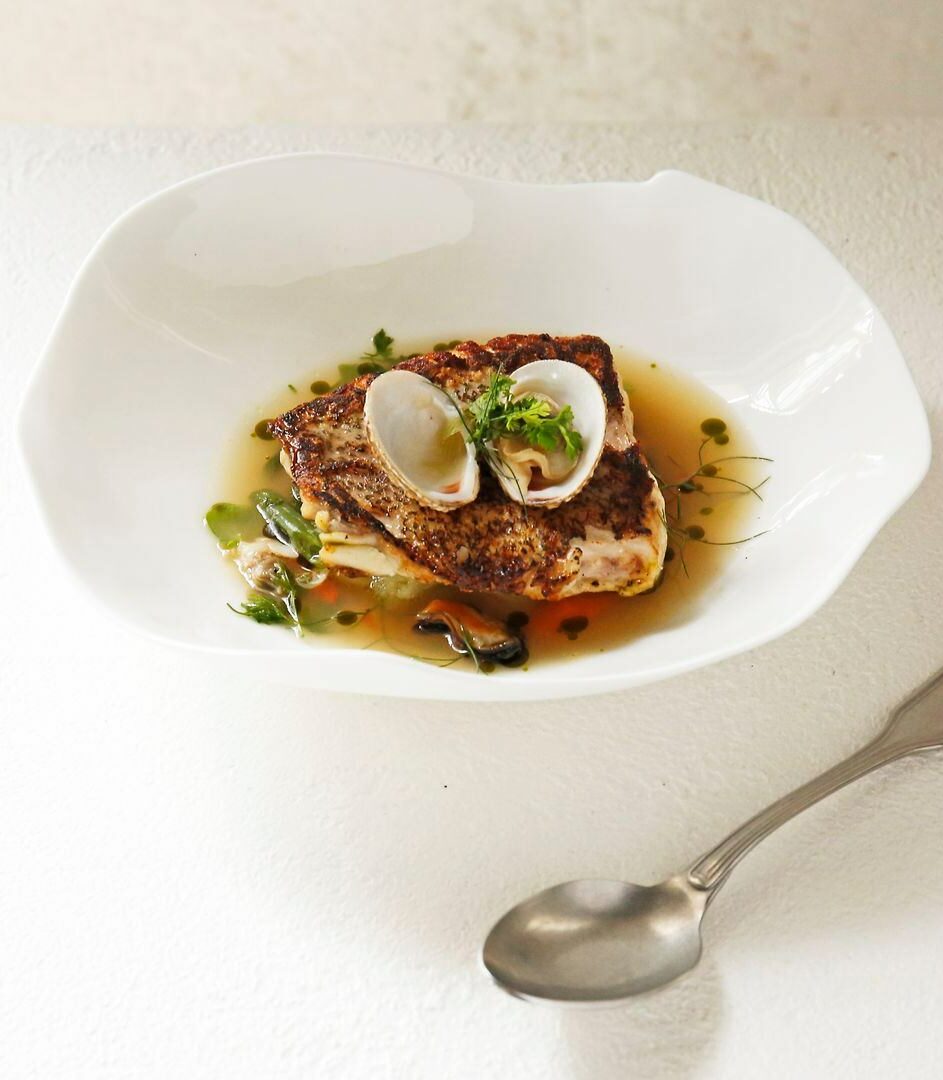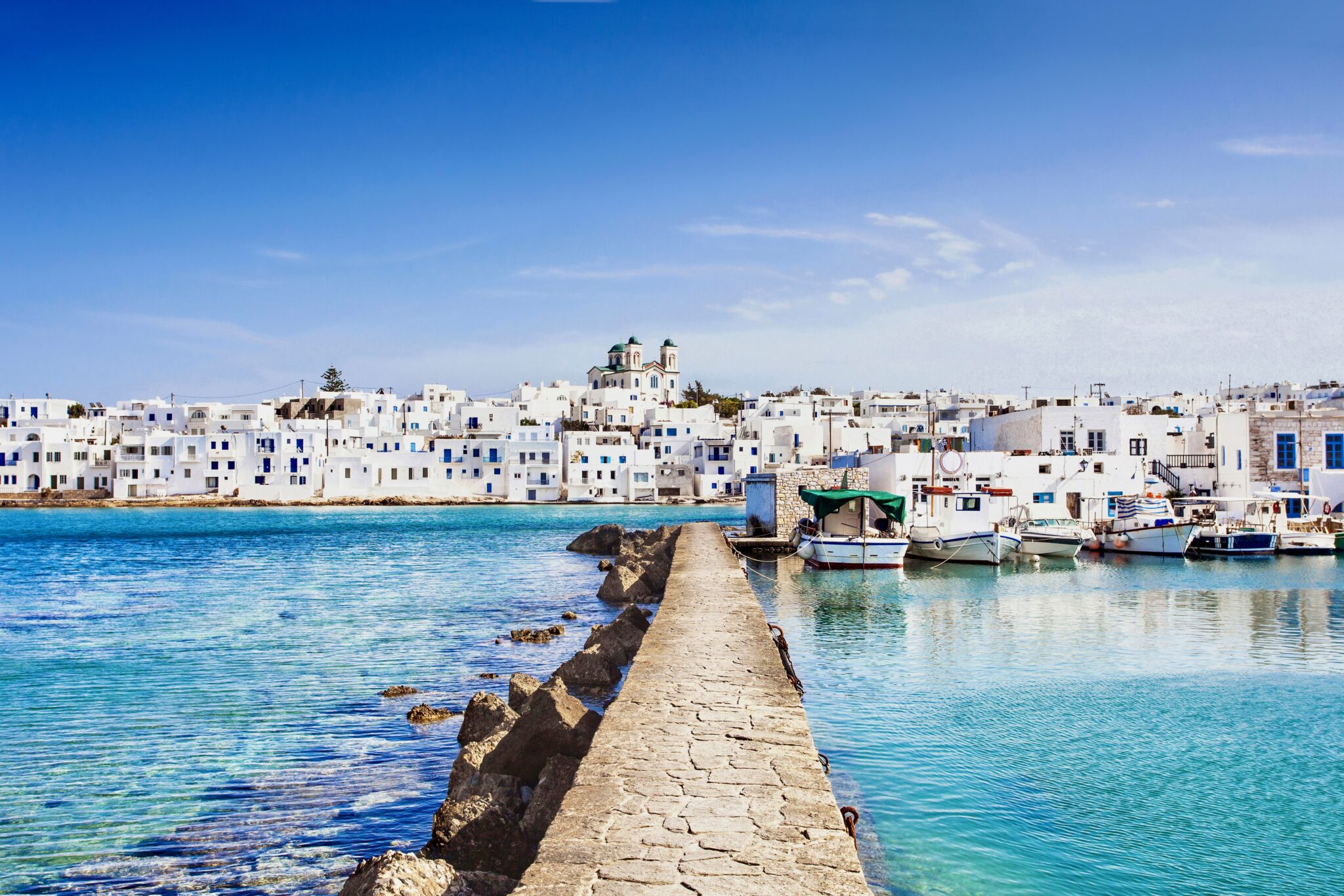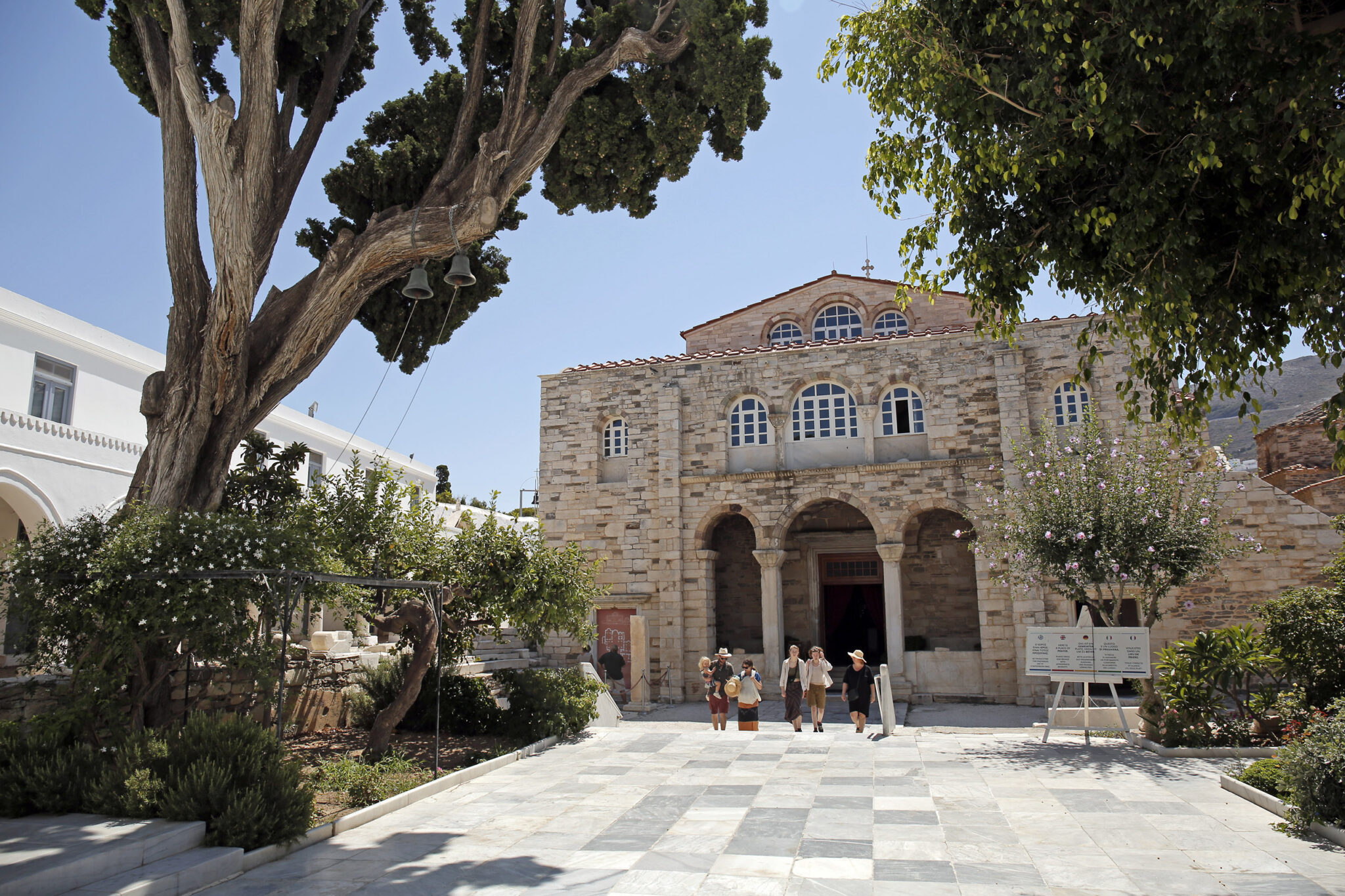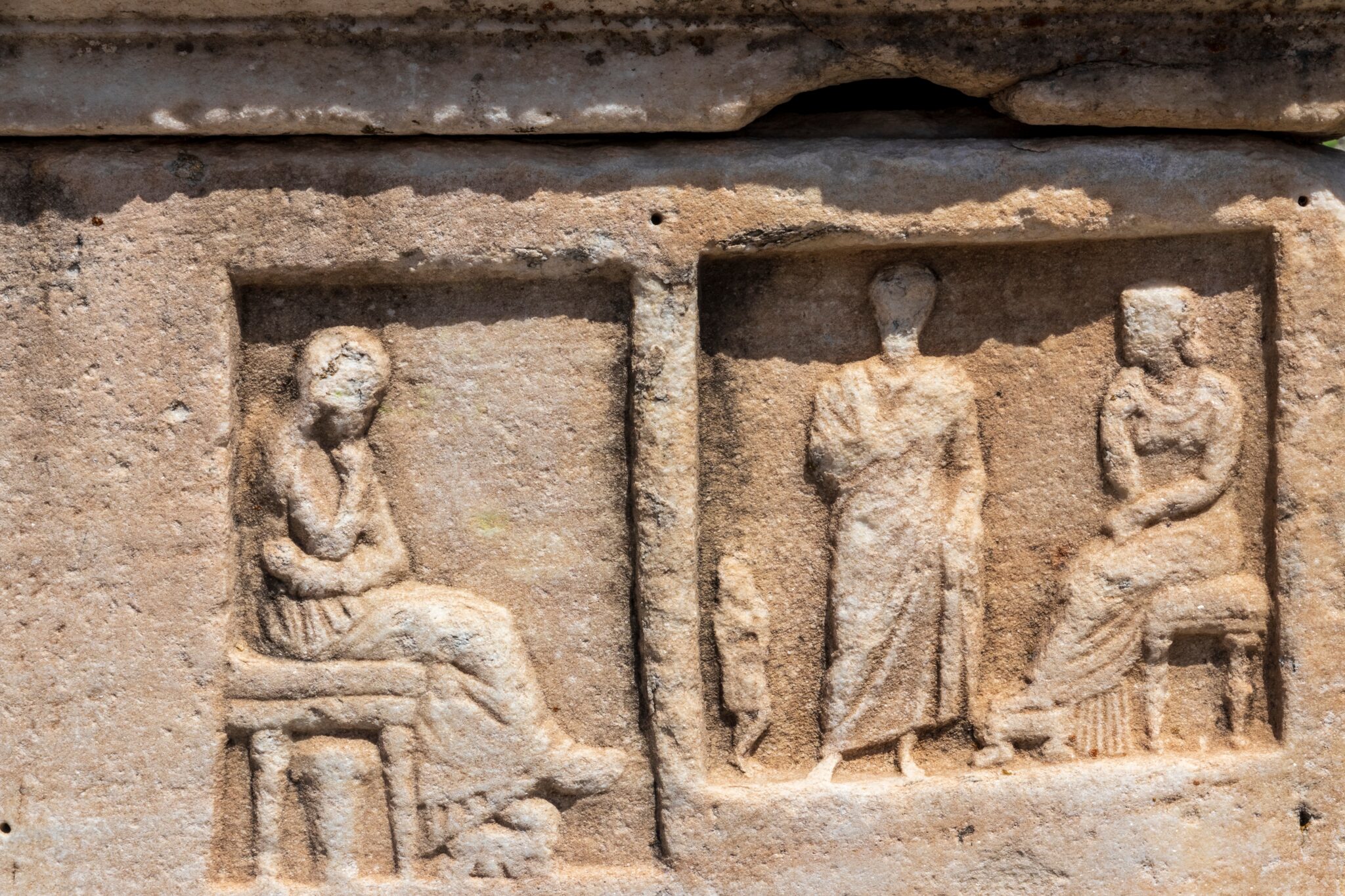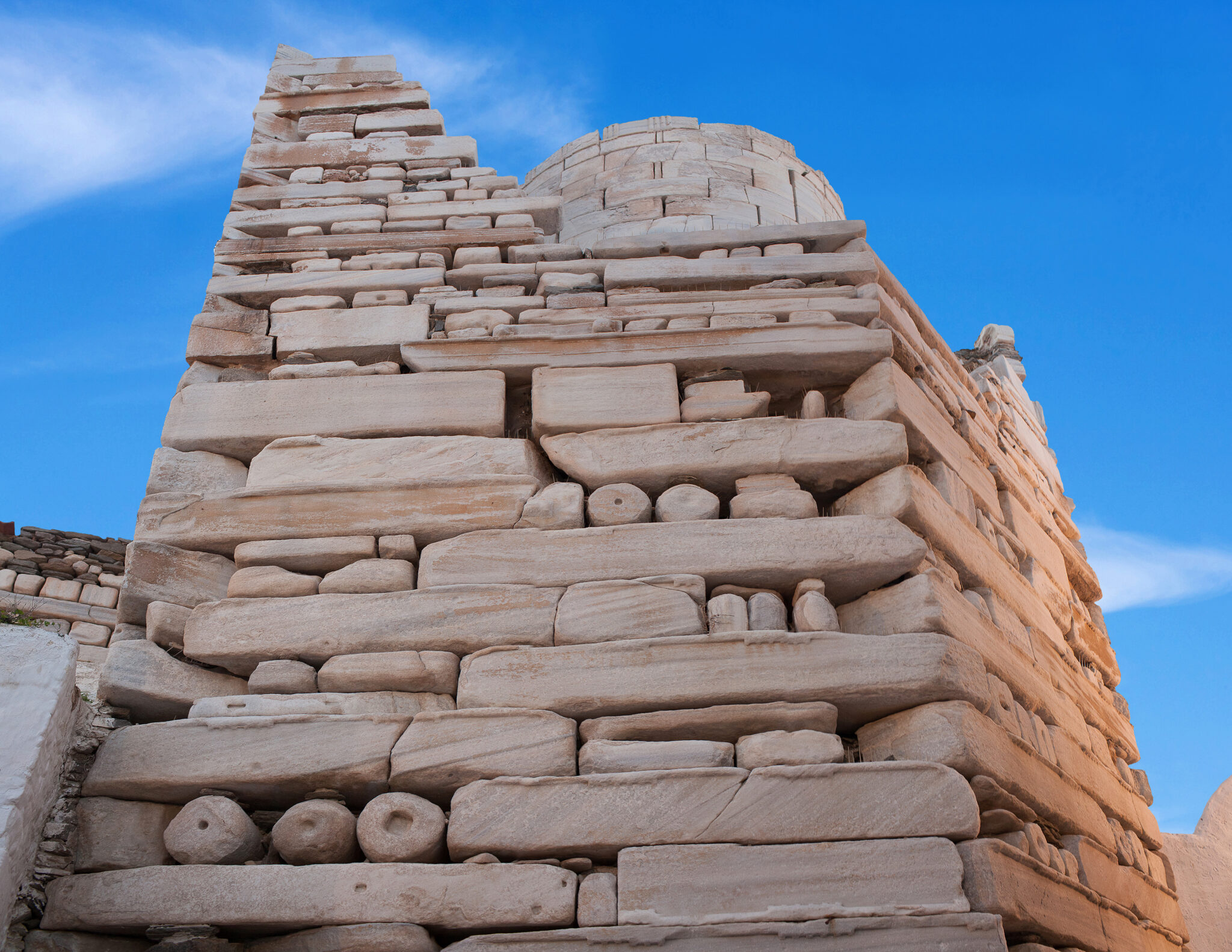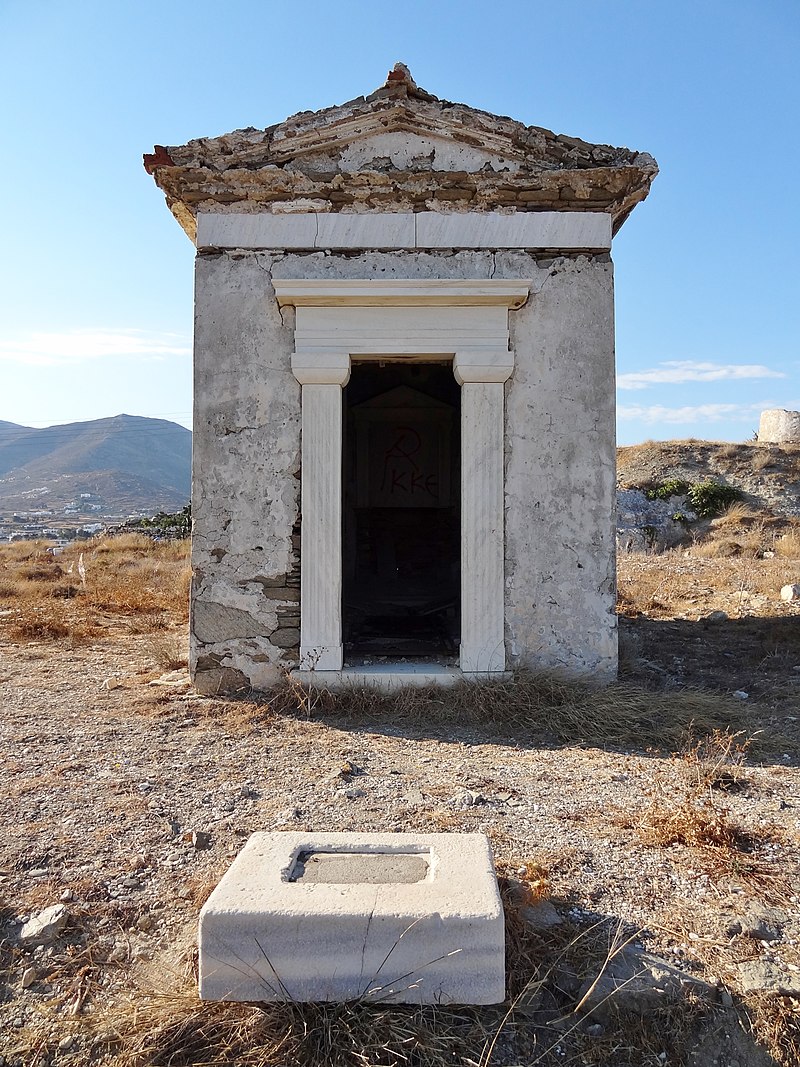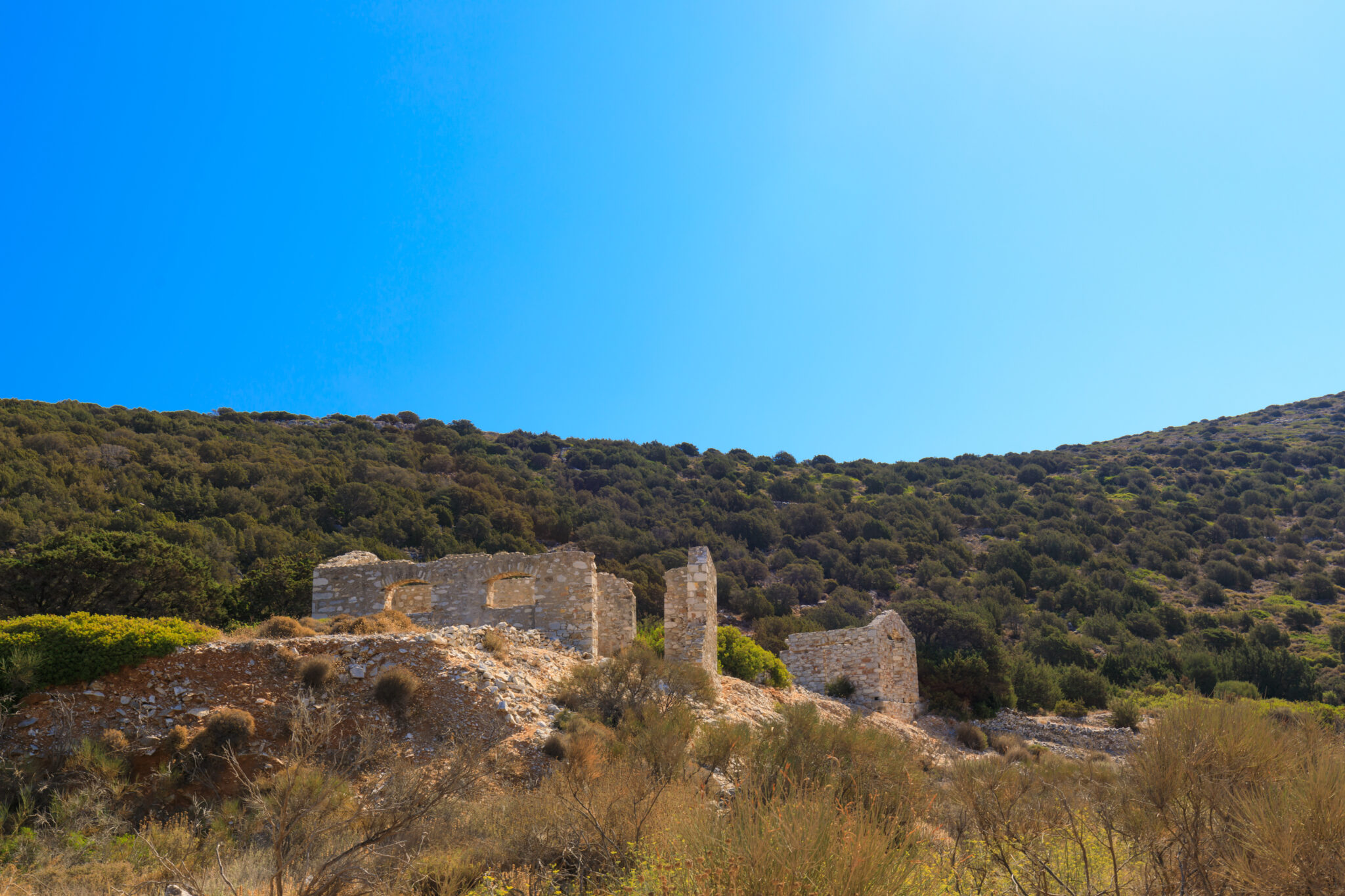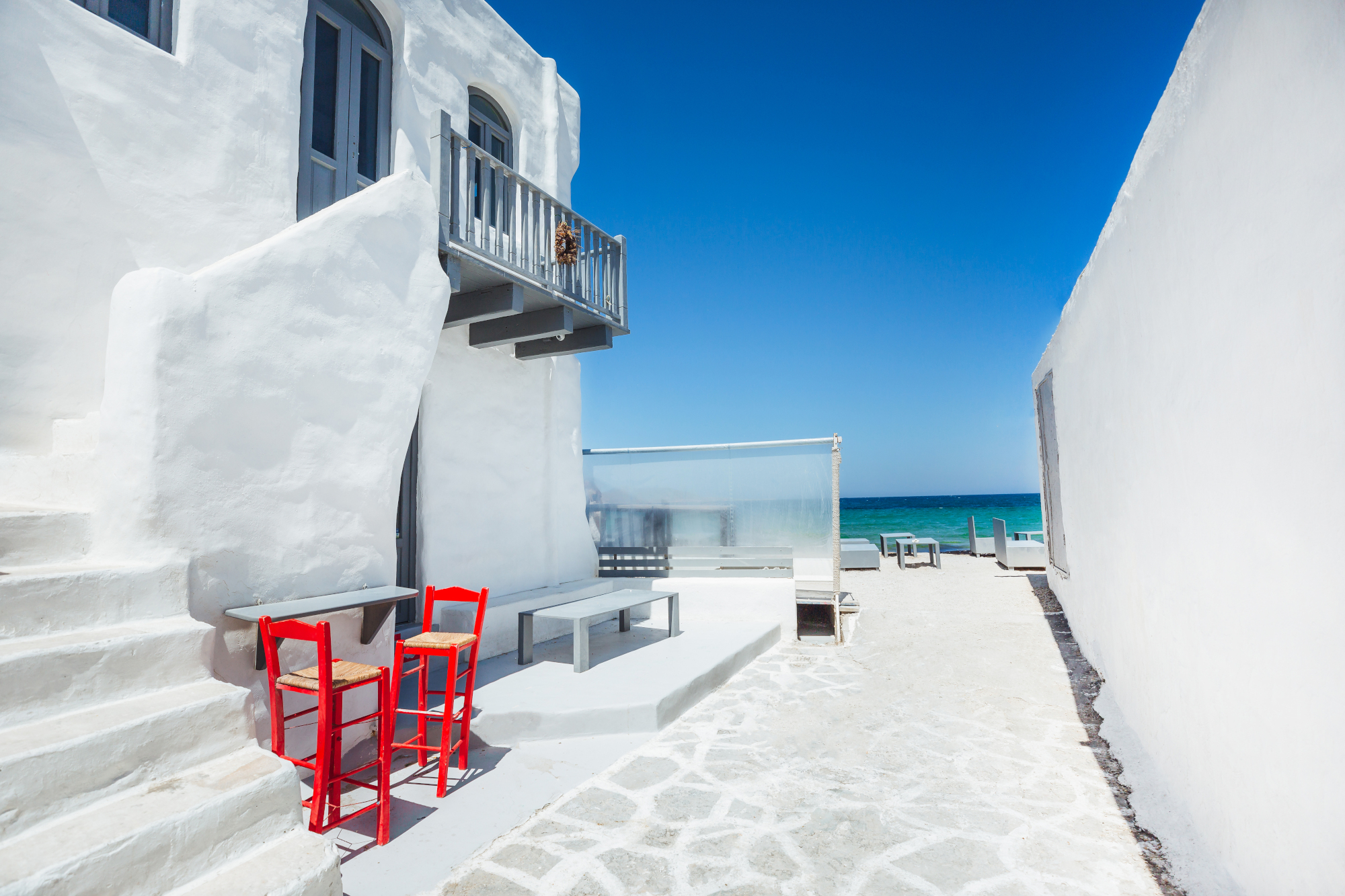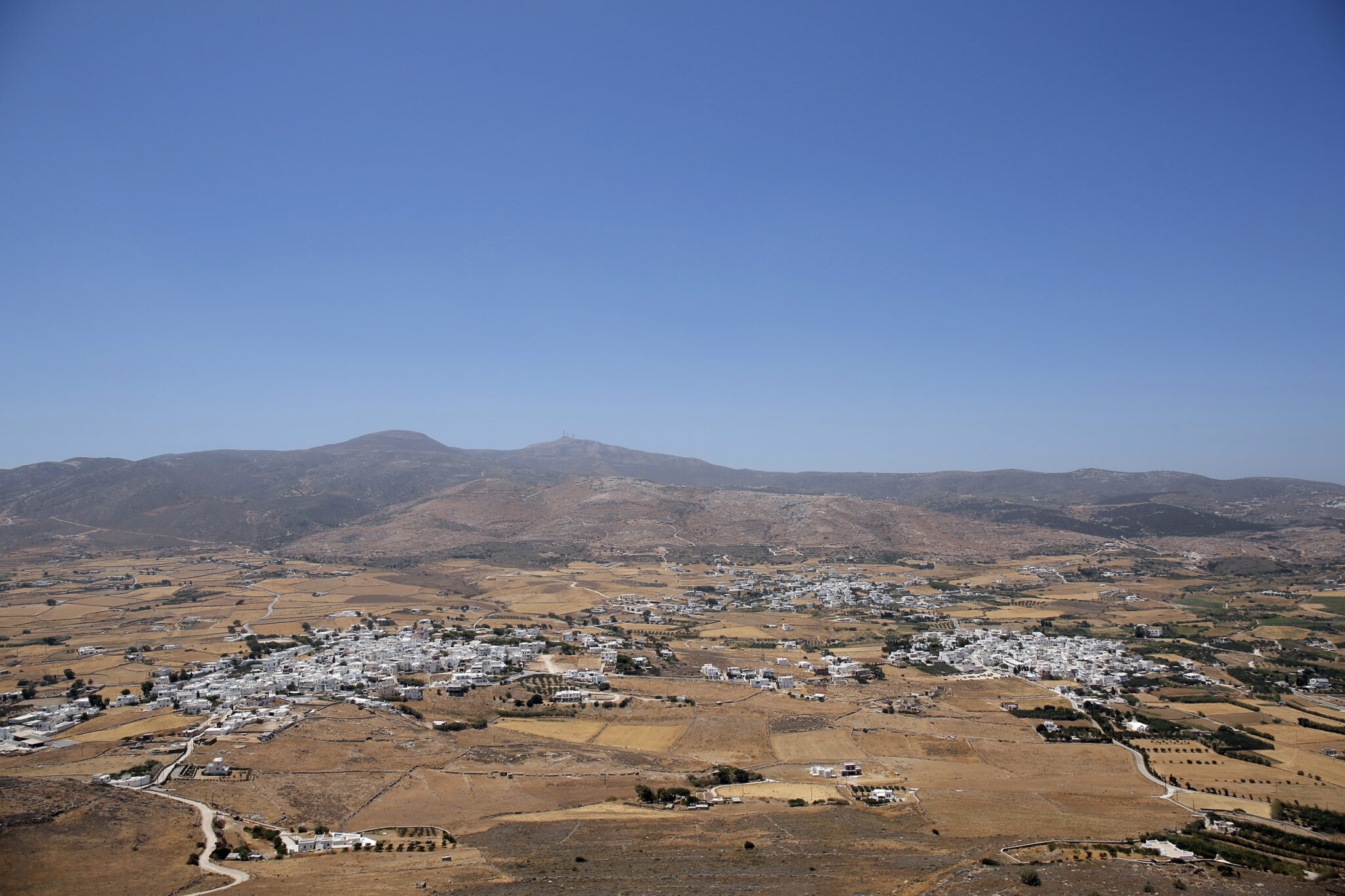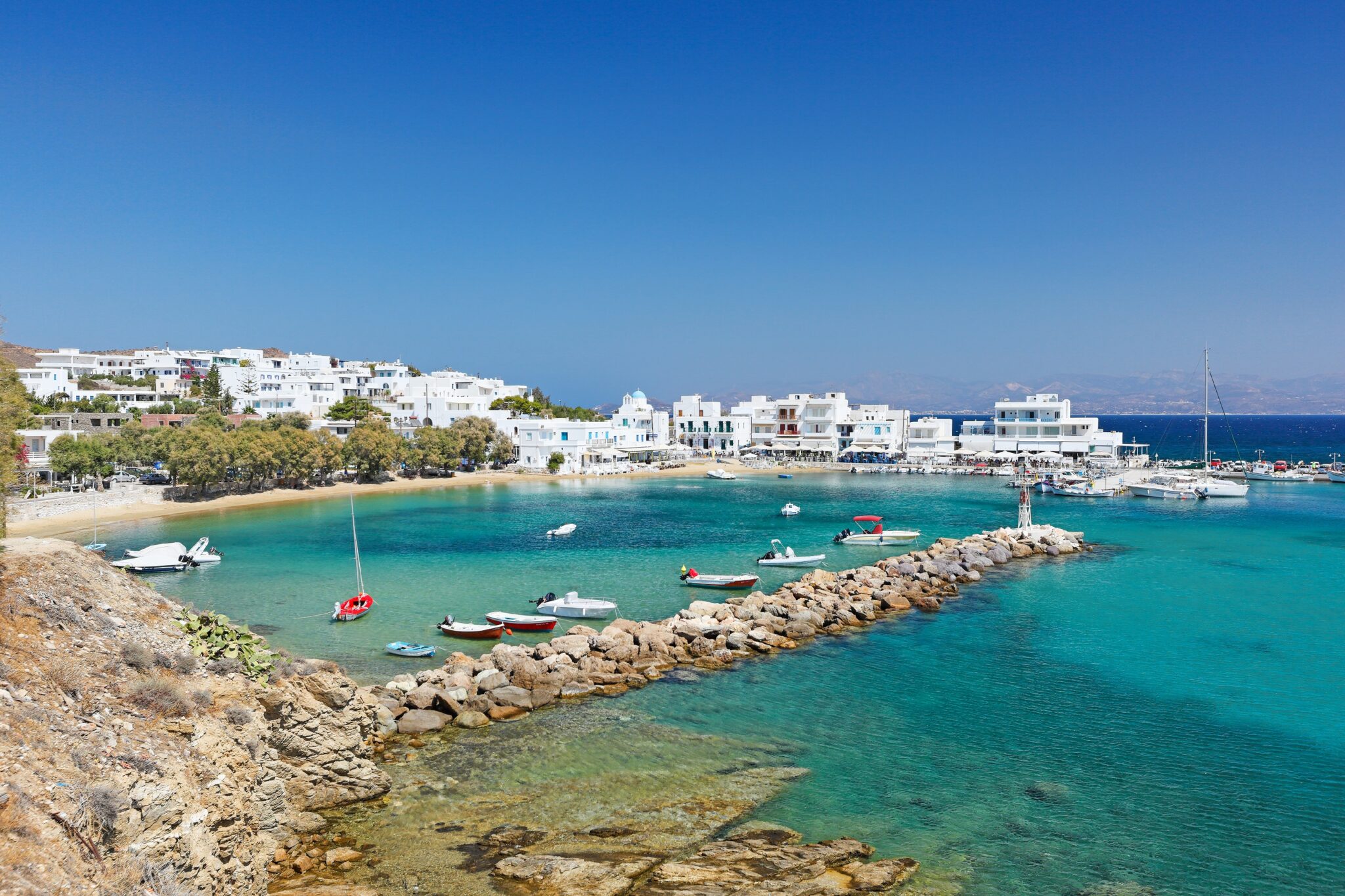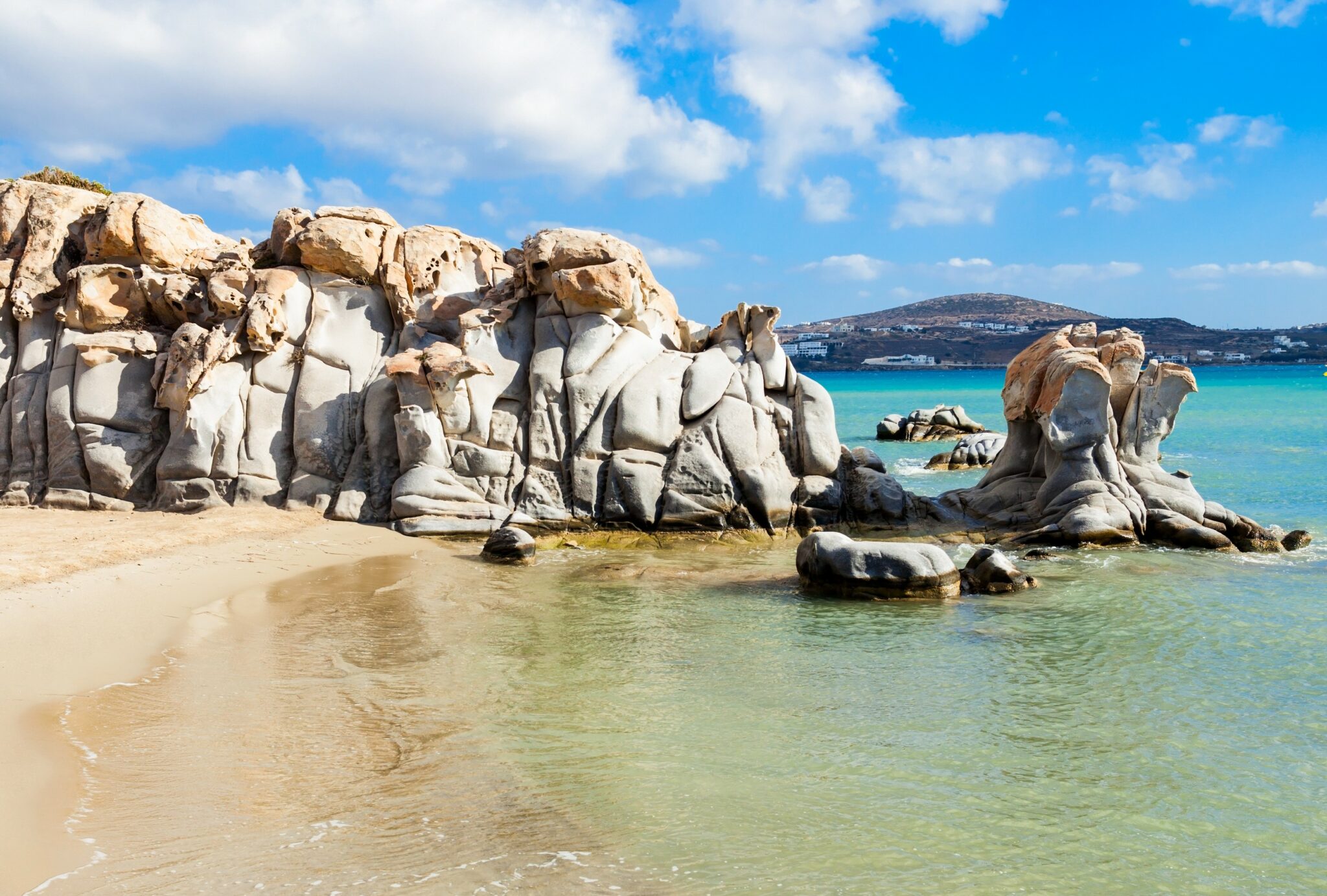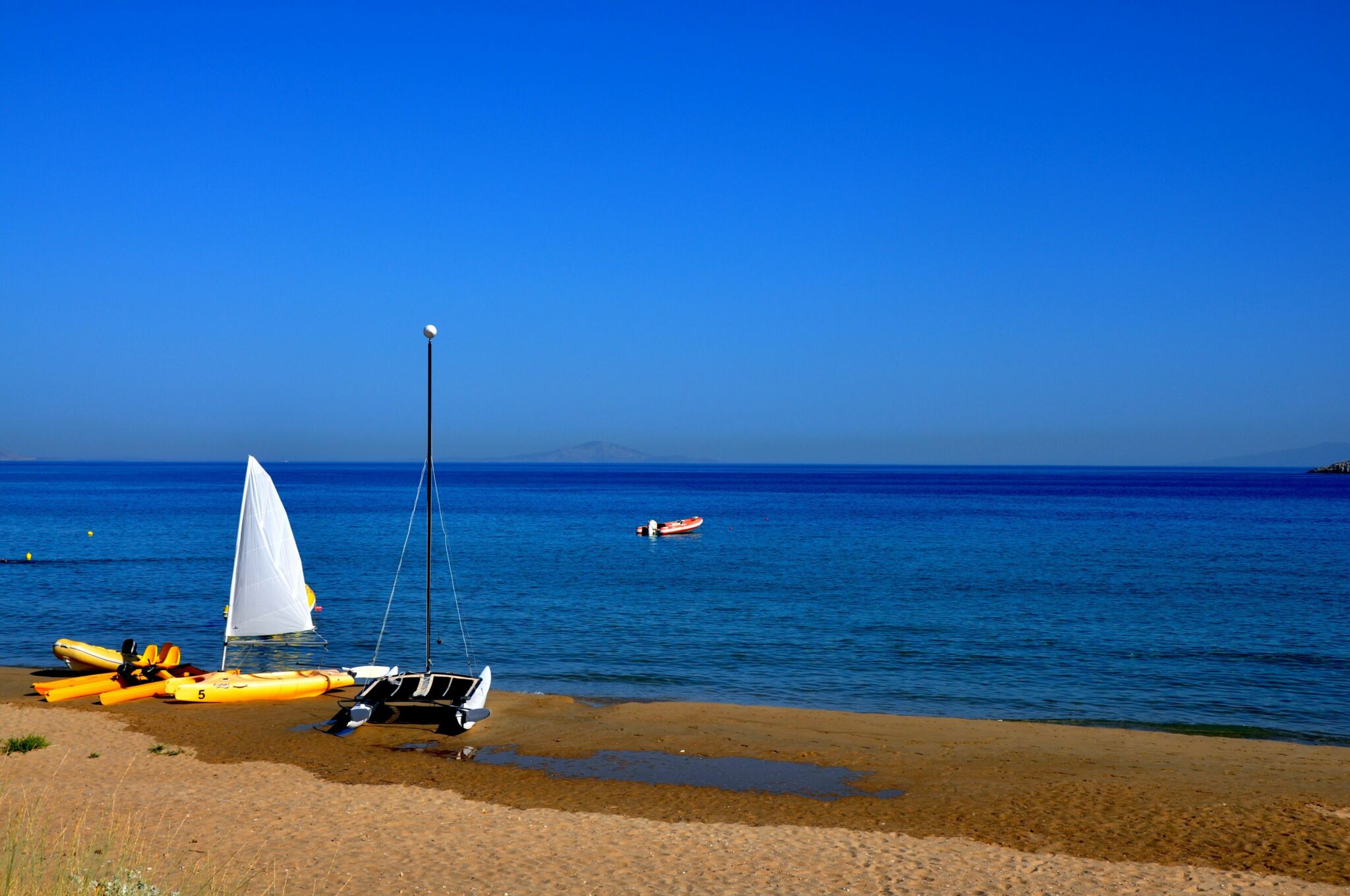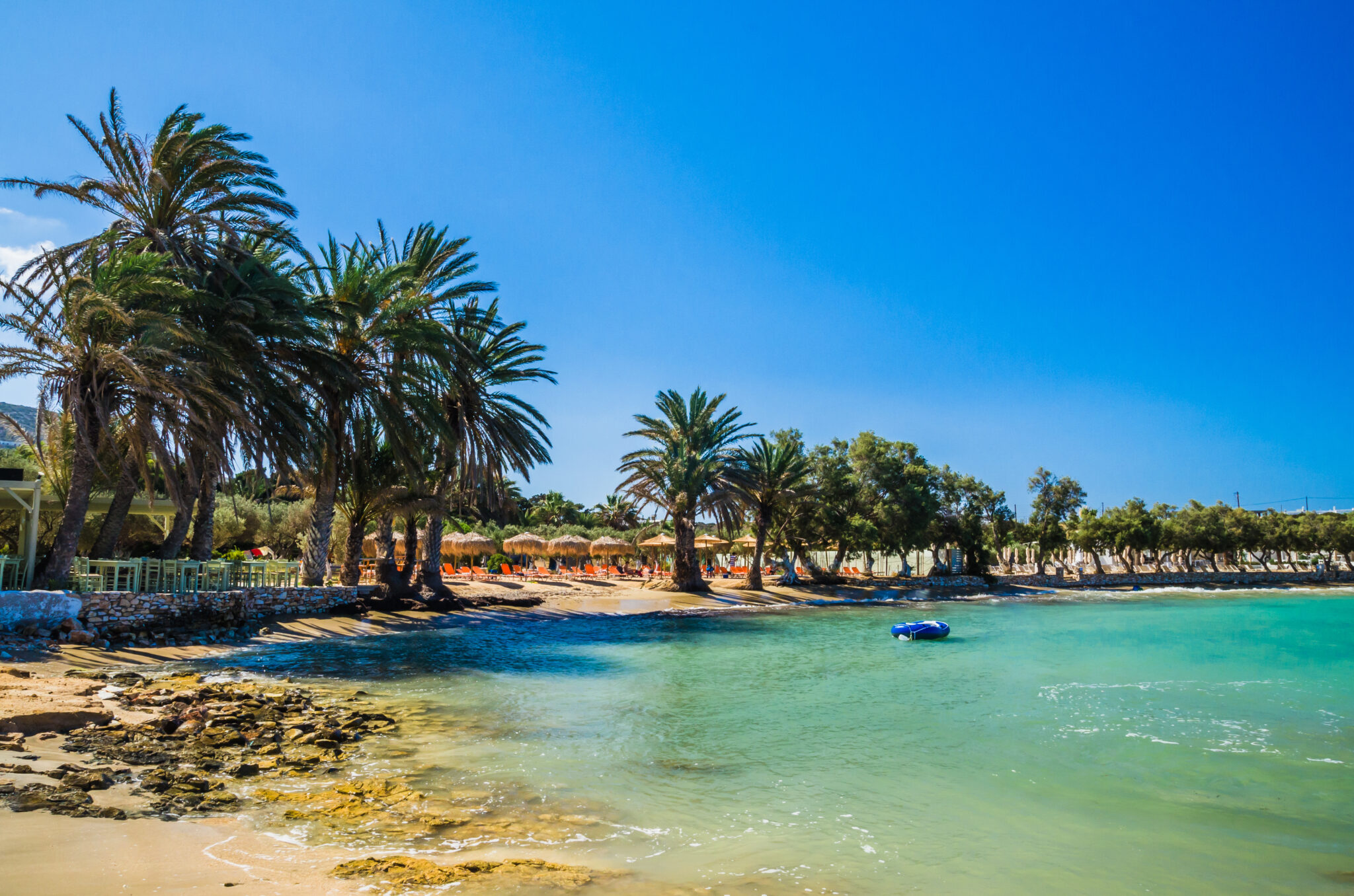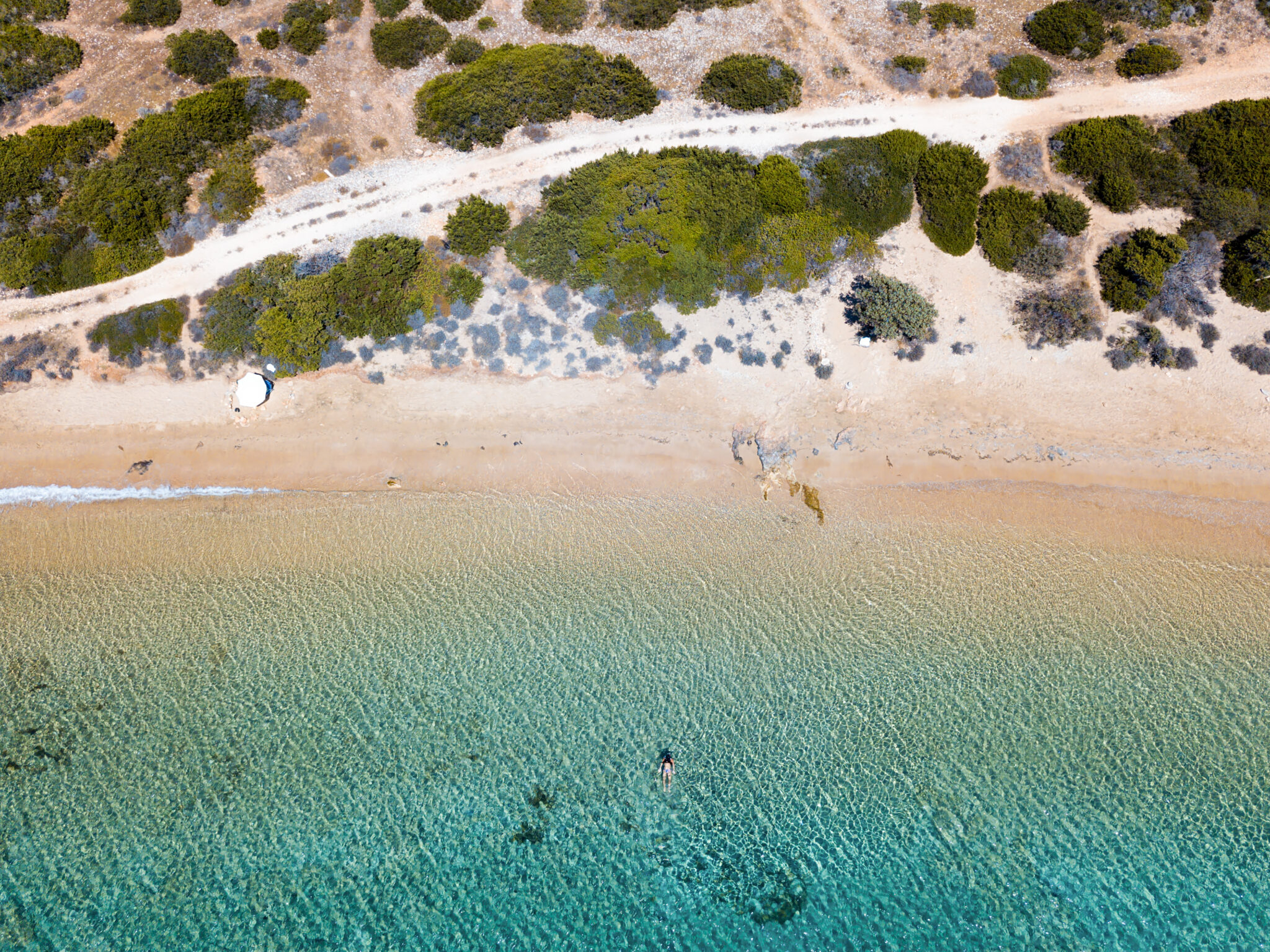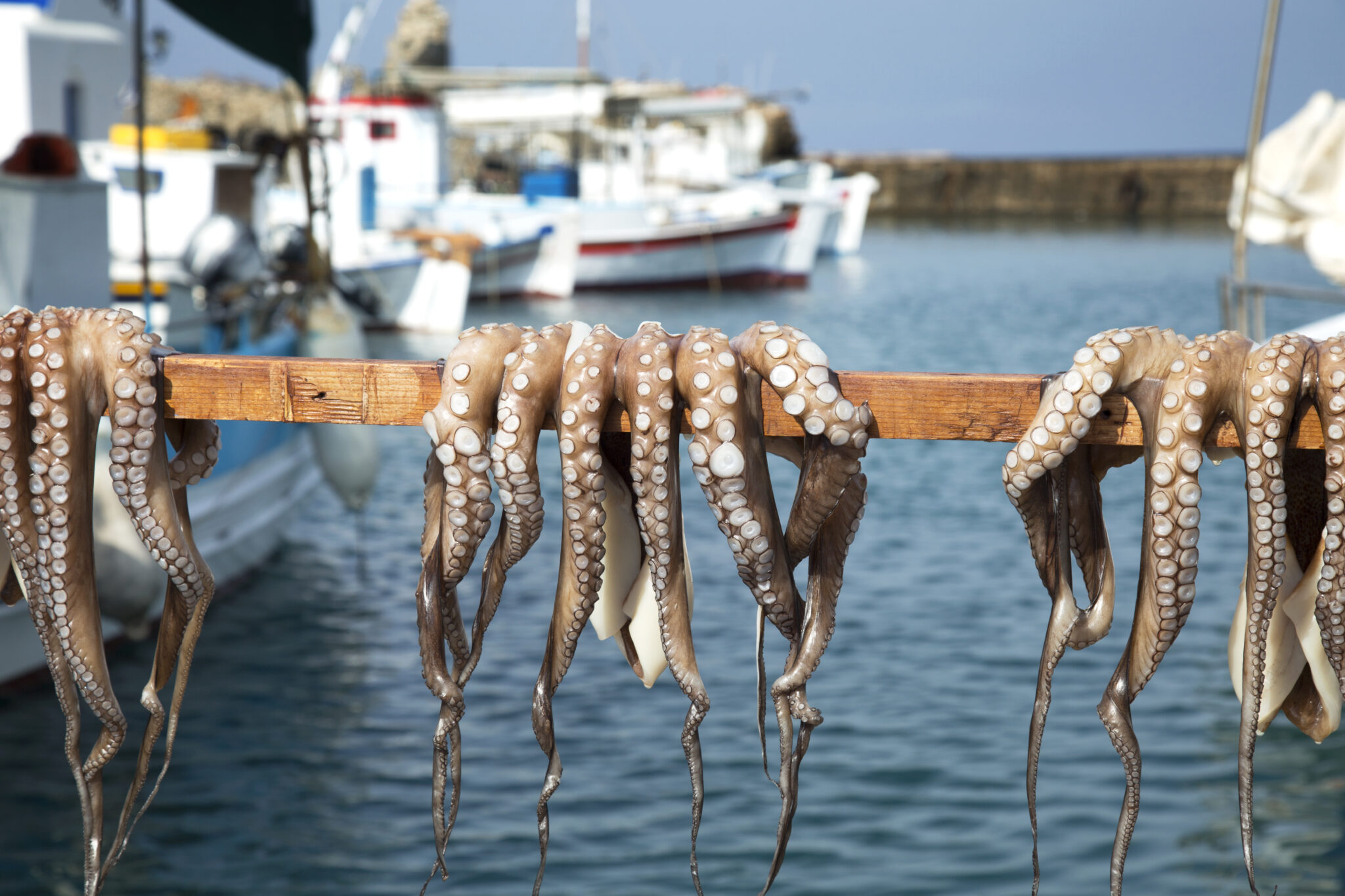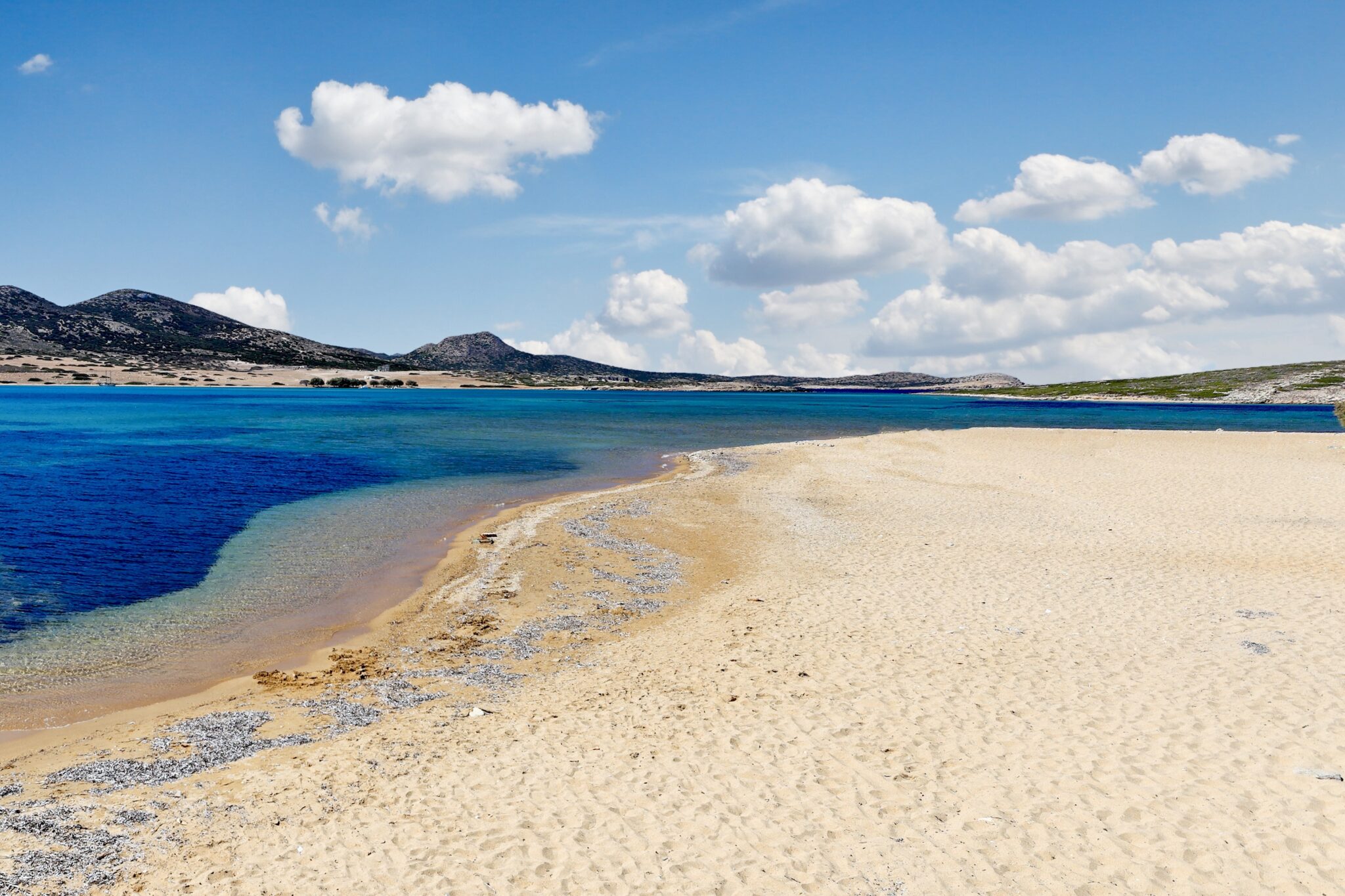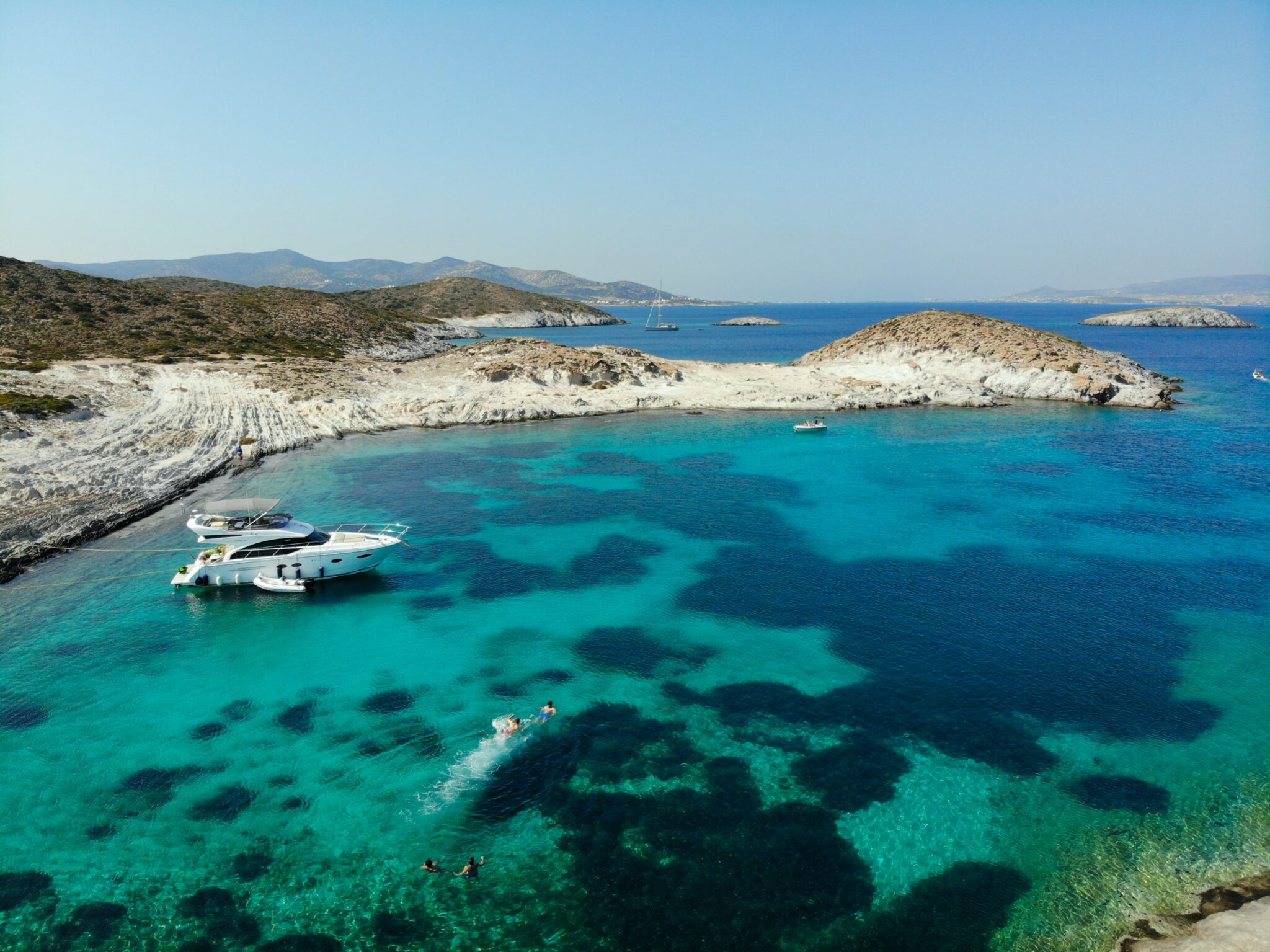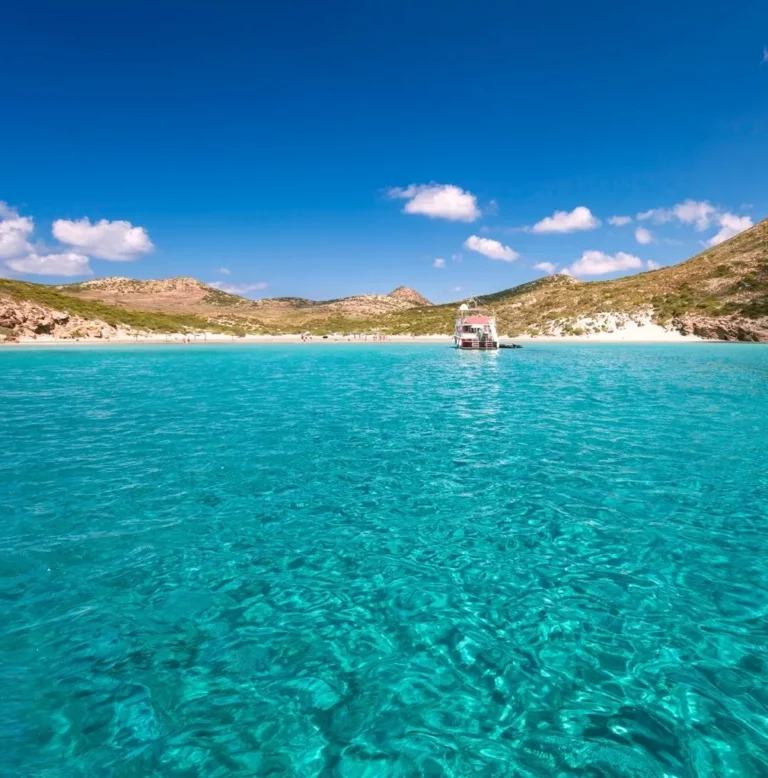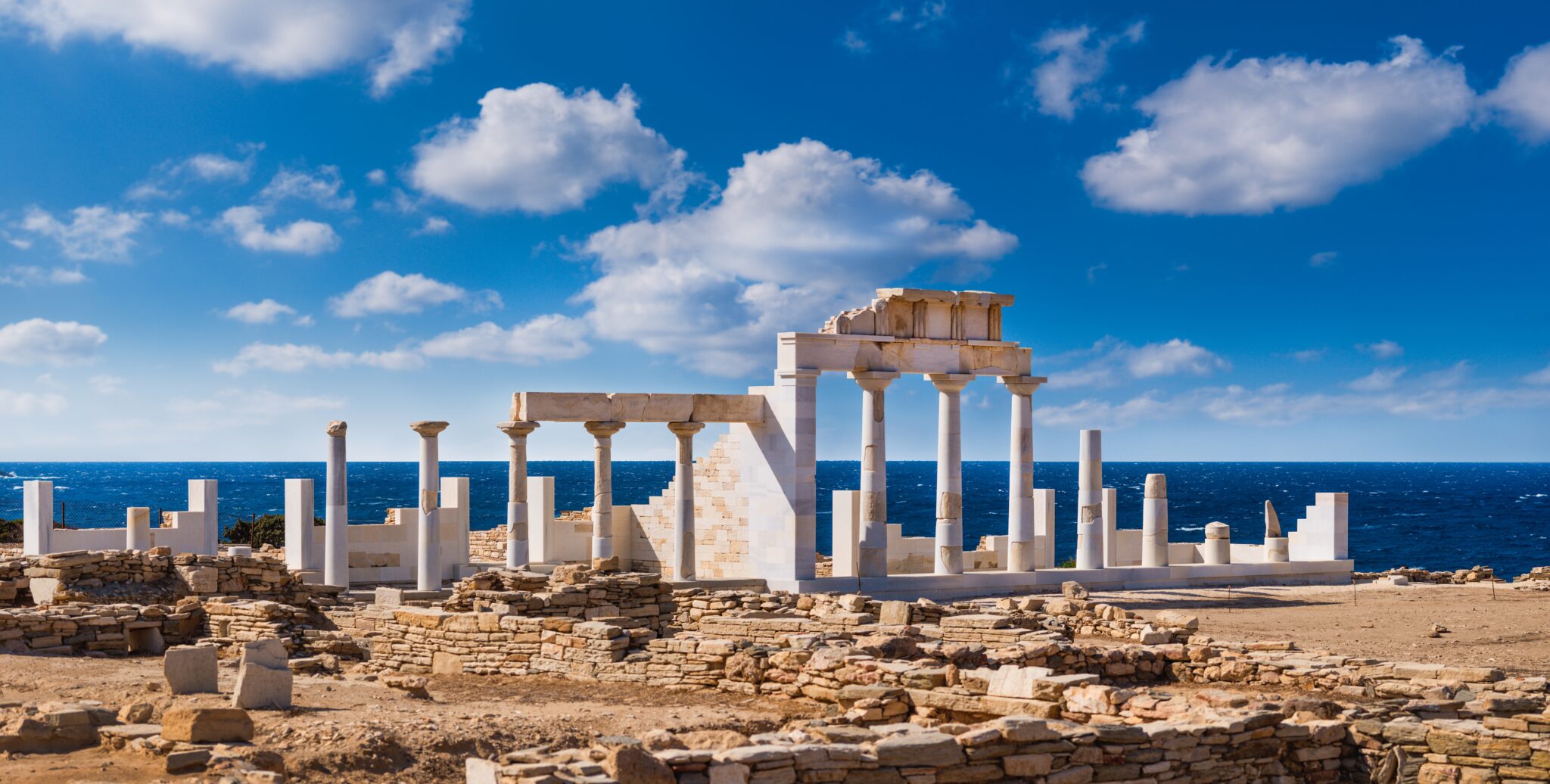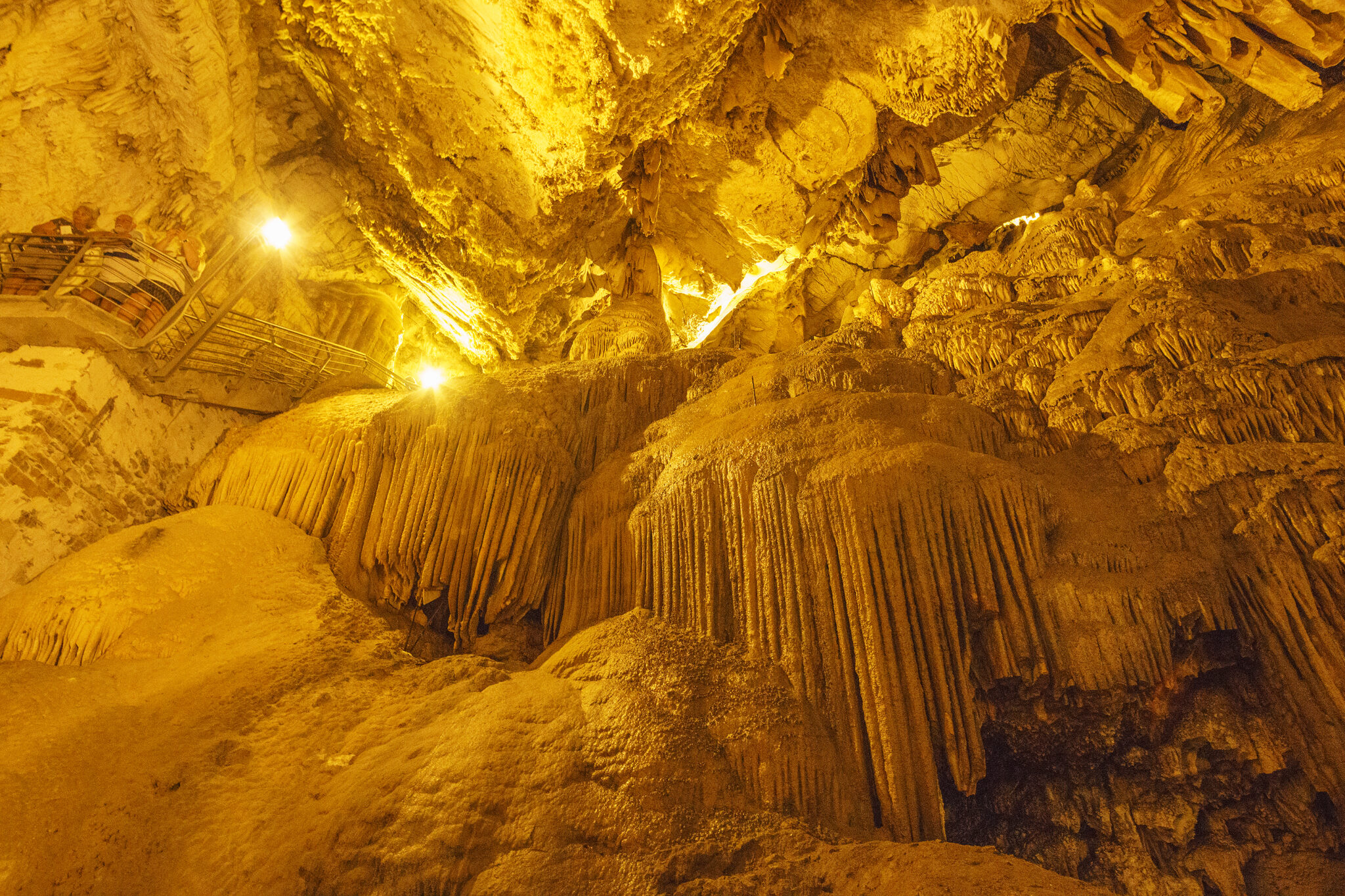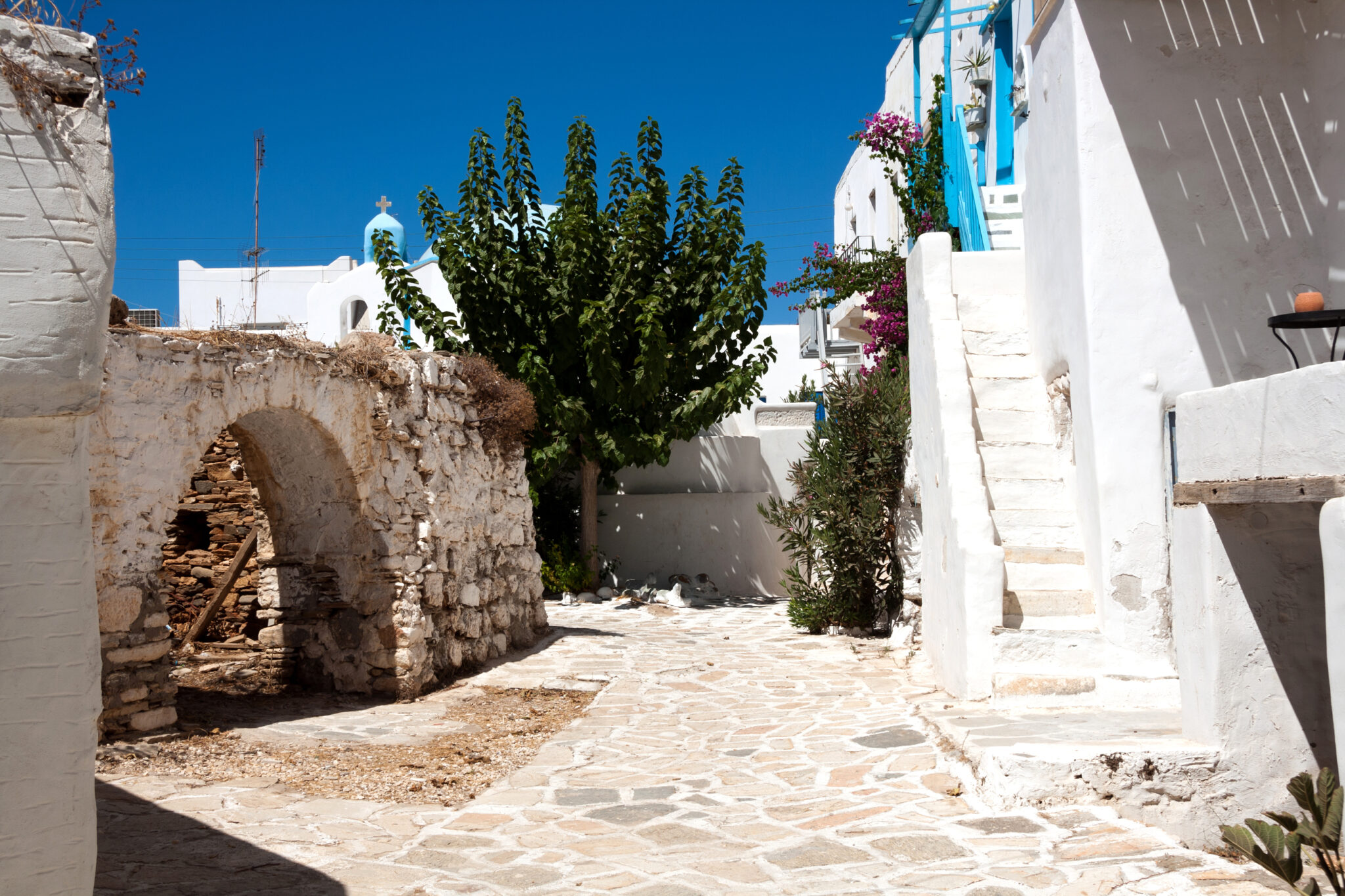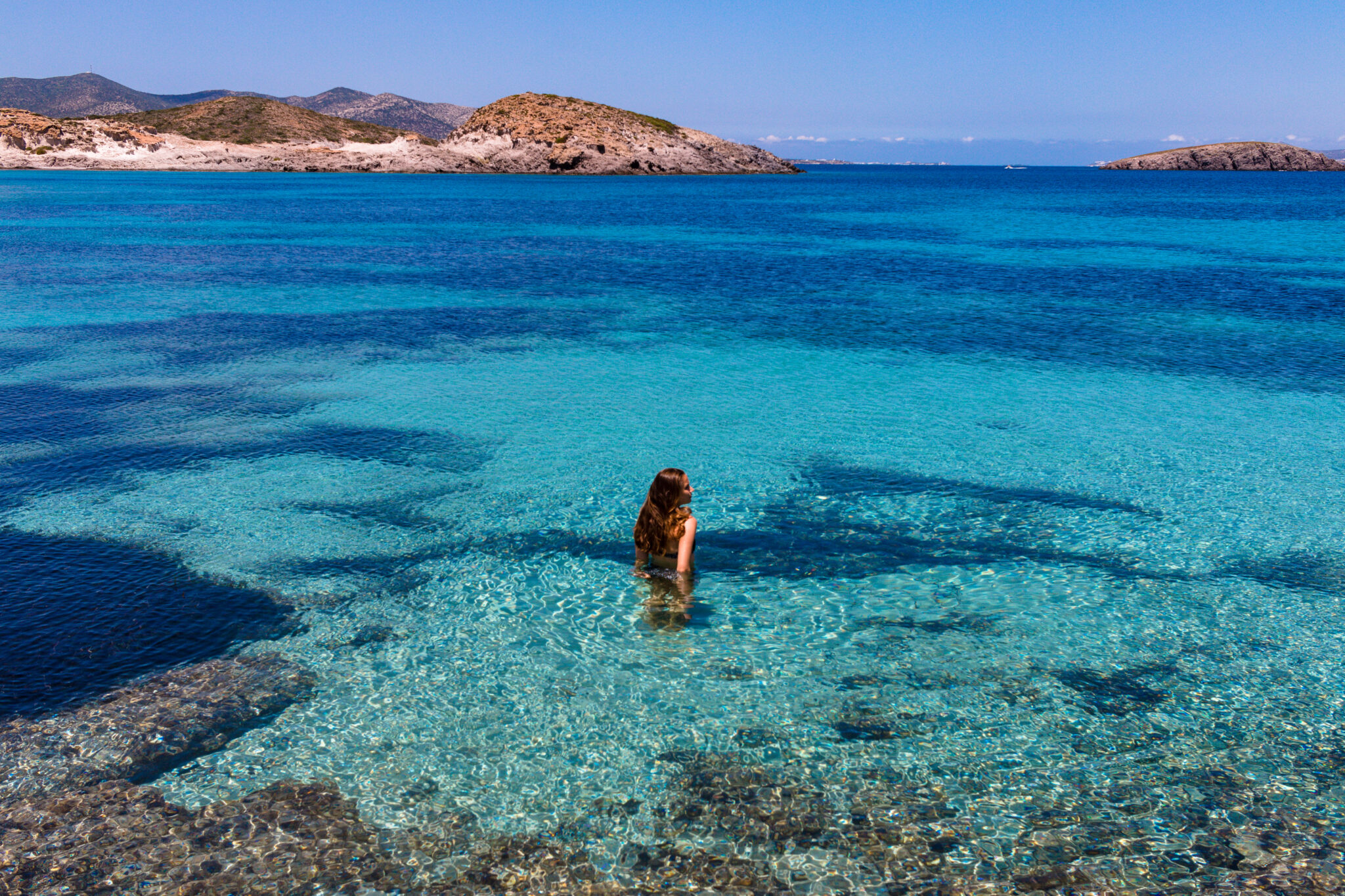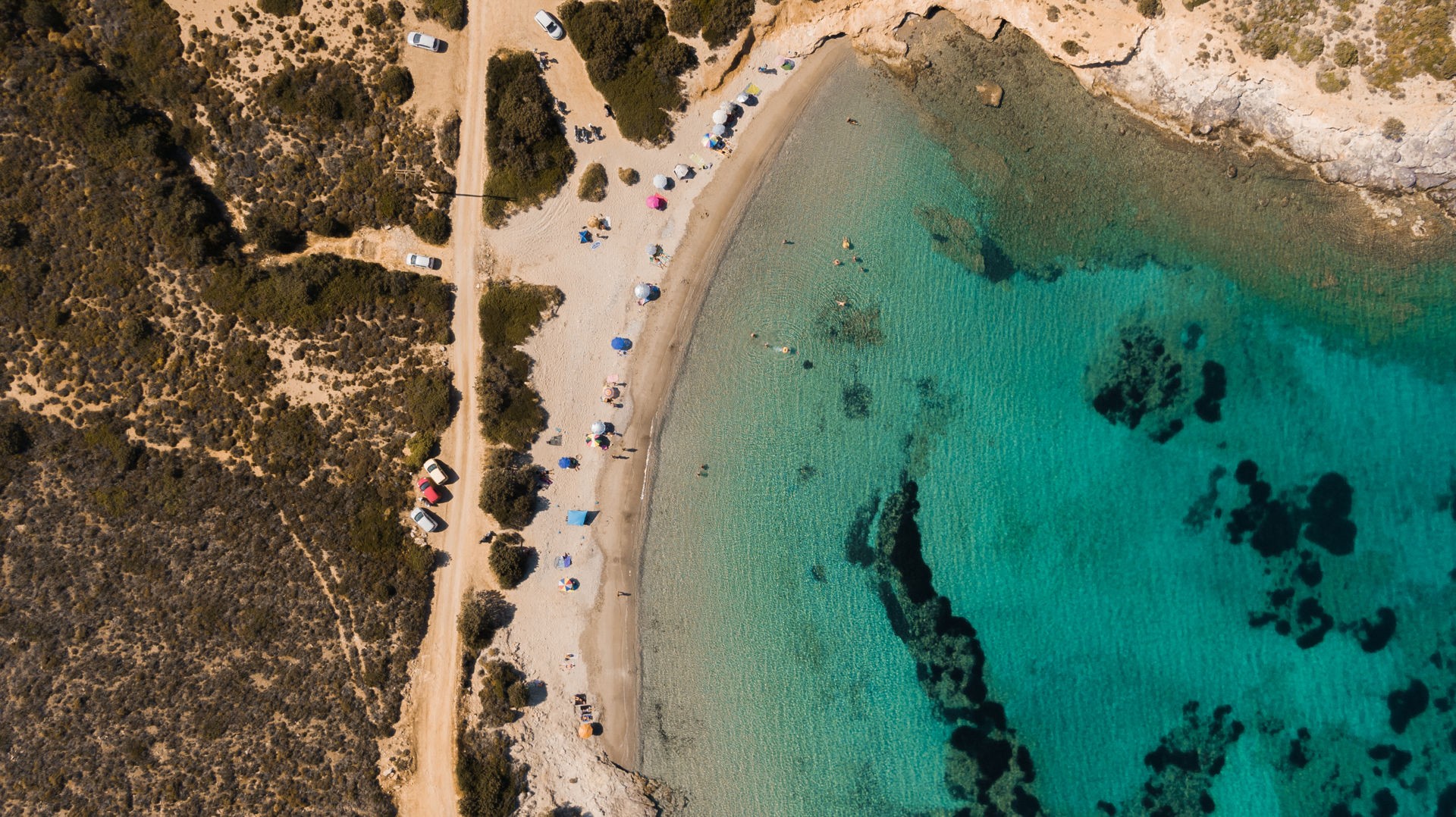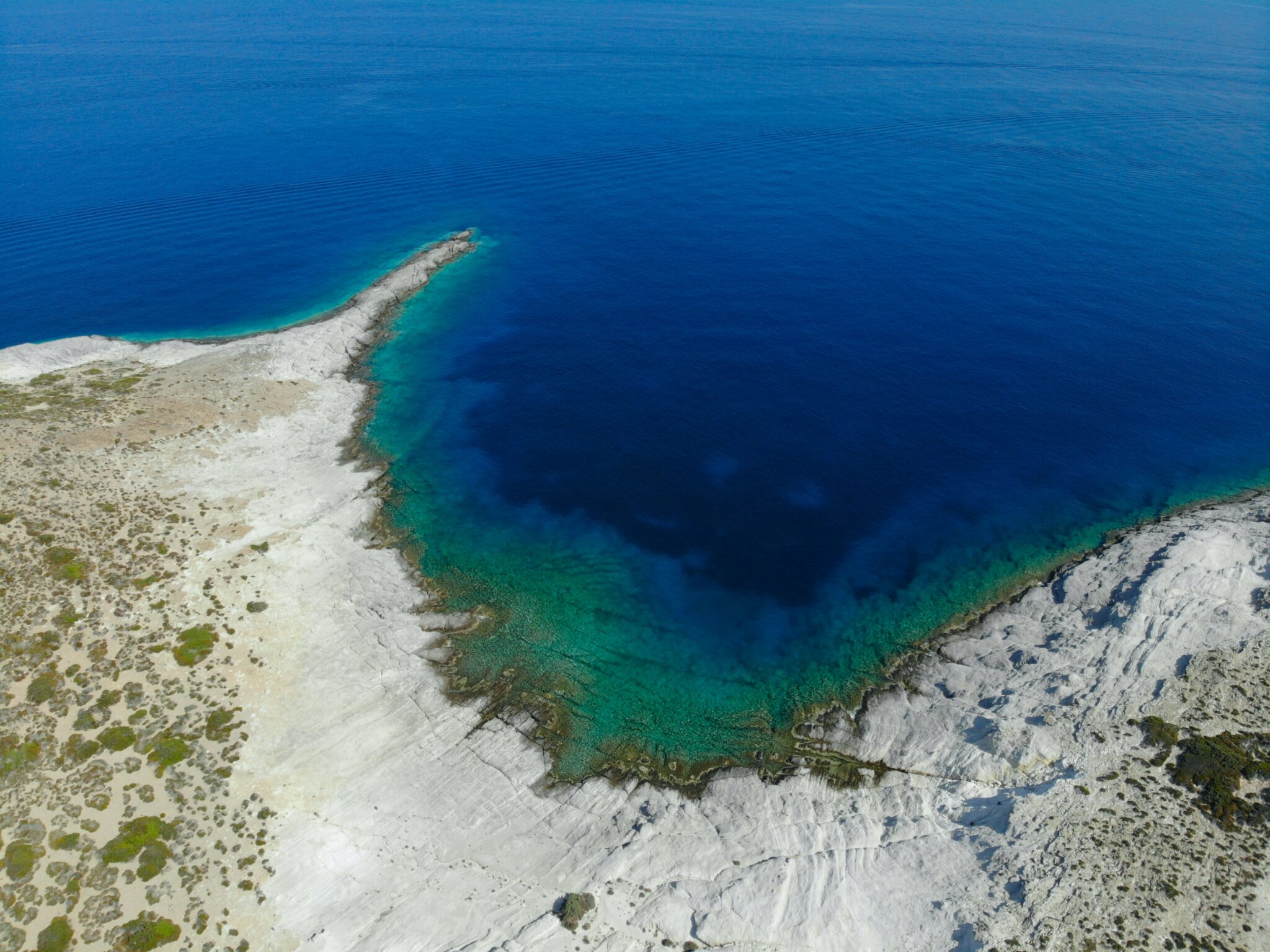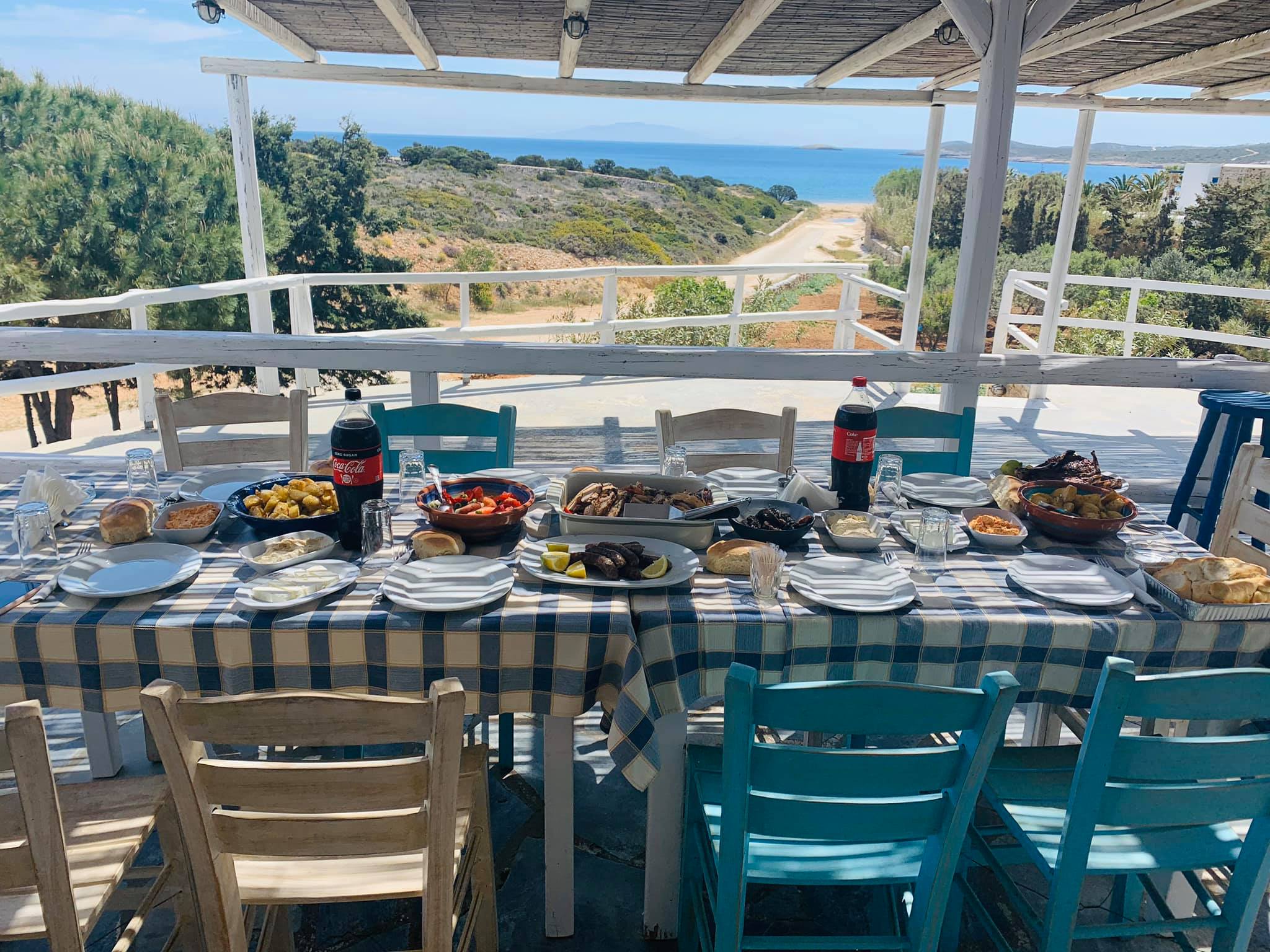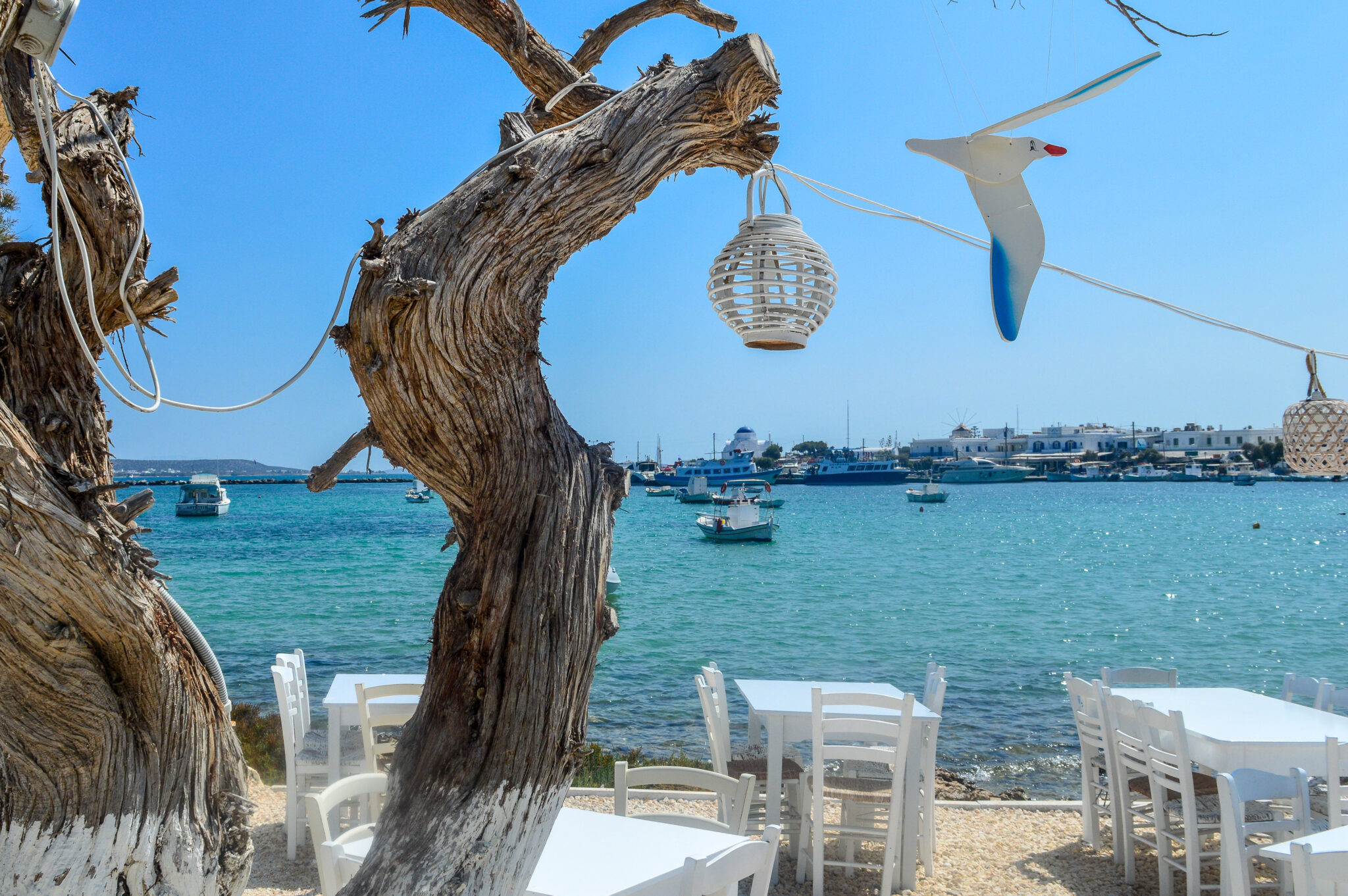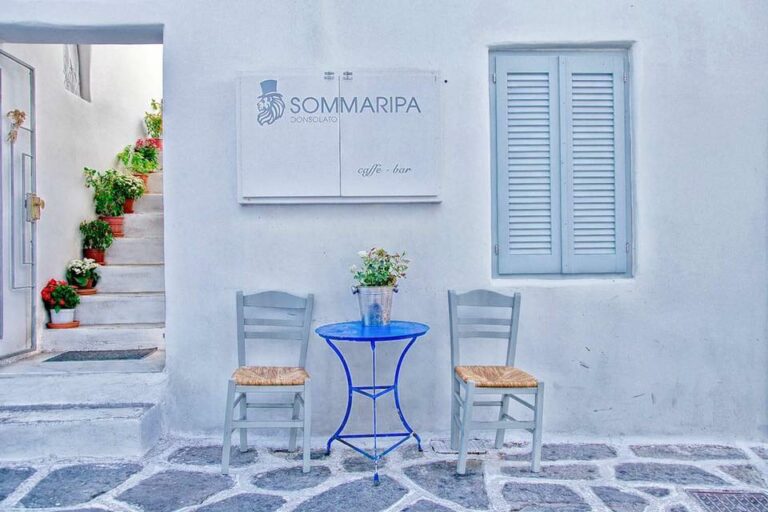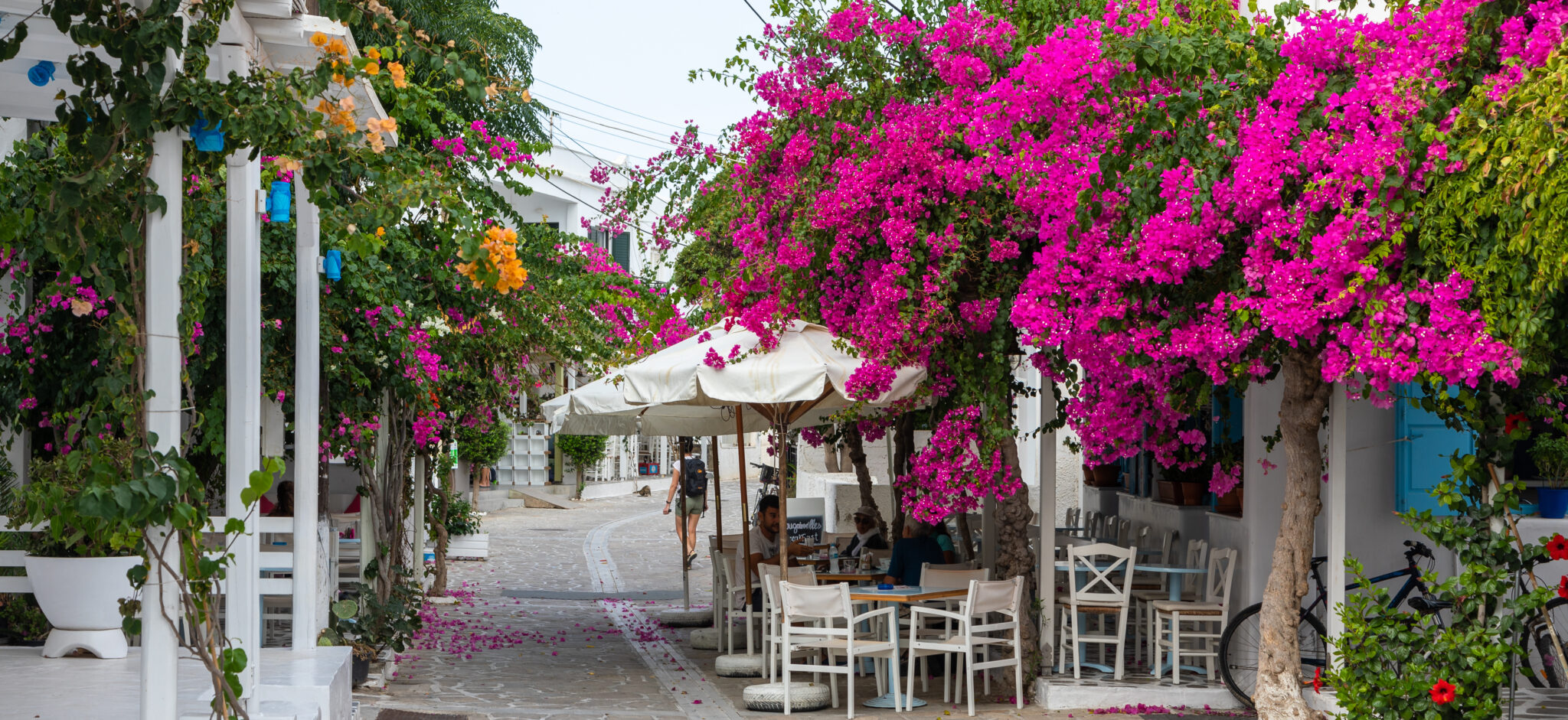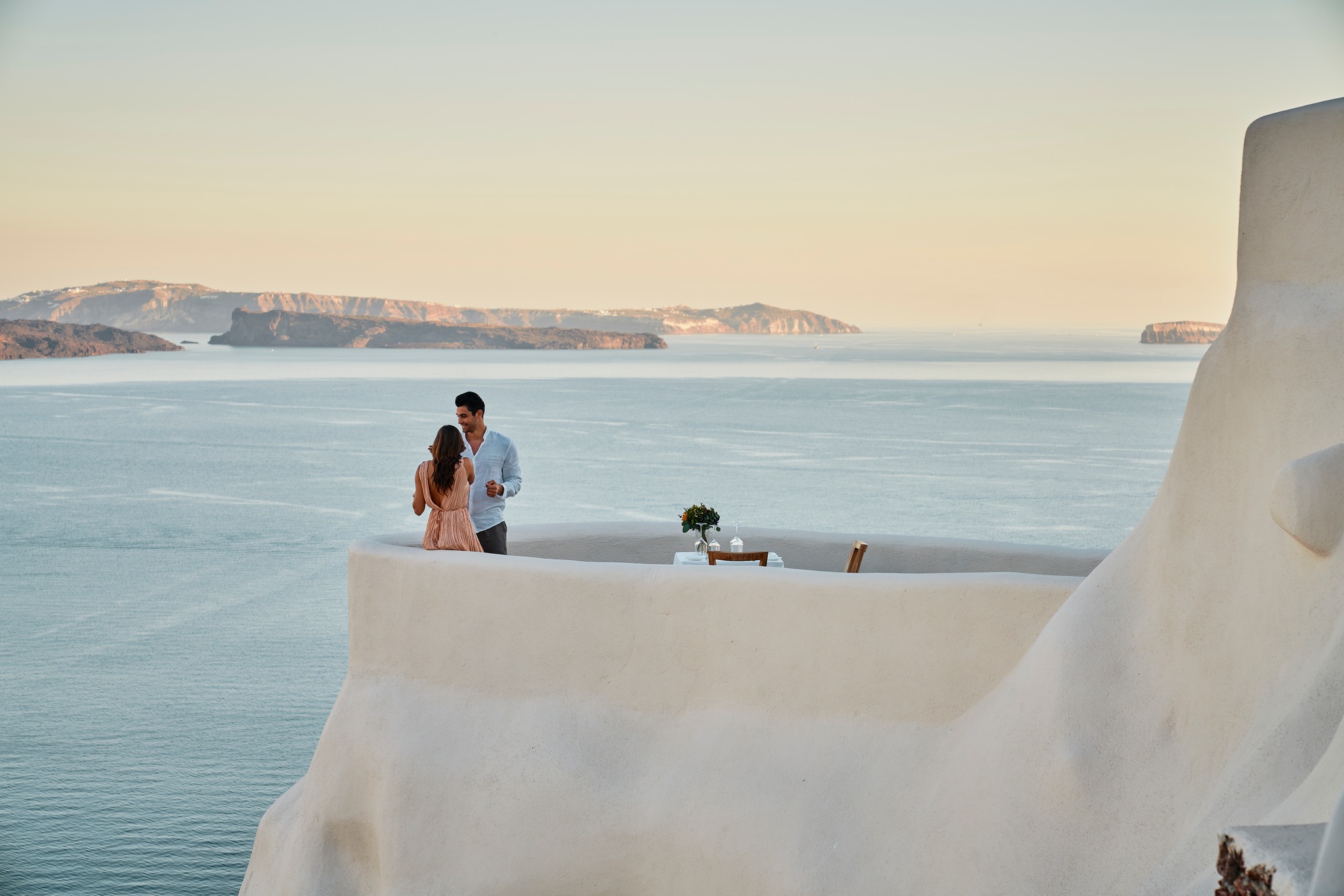Set off on your Cycladic adventure by hopping between these three popular islands, each offering a distinct palette of Greek island life, from the serene and traditional to the modern and spirited. Begin in Naxos, the largest of the trio, renowned for its expansive beaches and rugged landscapes, also a haven for hikers aiming to explore the ancient paths around its mythic ruins.
Then sail to Paros, where a lively atmosphere meets charming tranquility. Beaches such as Santa Maria offer excellent conditions for water sports, particularly windsurfing, while quieter, more scenic ones are ideal for families or chilling. The nightlife here thrives in beach bars and small clubs in Naoussa and Parikia, while the day is best spent exploring quaint villages or indulging in the local culinary scene, which features superb seafood and traditional Greek dishes.
Conclude your journey in Antiparos, just a short ferry ride from Paros. This smaller, quieter island is perfect for those looking to escape the larger crowds (and also for jetsetters). Its beaches generally offer a more intimate experience, from snorkeling in crystal-clear waters to enjoying the laid-back pace of island life. The local food scene, characterized by its simplicity and freshness, invites diners to linger over meals in cozy seaside tavernas.
Naxos to Paros
Duration: 1 h
Price: ~ €15
Paros to Antiparos
Duration: 10 m
Price: ~€2
01
Naxos
Naxos is made up of villages hardly touched by time, ancient sites that have withstood millennia of change, tavernas serving delicious food, and a culturally rich array of fresh tastes, cultural landmarks and nature. Visitors quickly understand the impressions of the historian Herodotus, who once penned a heartfelt tribute to the island, praising its myths, wealth, and the impressive statues of Kouros that adorn the temples across the Cyclades, shining brilliantly through the annals of time.
A. Highlights
Naxos Town
Naxos Town (Hora) With a wide range of attractions, shopping experiences, culinary treasures, nightlife, vacation homes, hotels, and boutique accommodations – is a vibrant hub that you’ll delight spending time in throughout your getaway. Cafes, bakeries, and restaurants serving dishes made from the famously fresh local produce, along with a selection of international and sophisticated contemporary cuisines, line the waterfront and serpentine alleys.
The Castle and the Portara
The best-known attractions in the Town are the castle of Naxos and the much-photographed Portara. Believed by archaeologists to be the grand entrance of the Temple of Apollo, the Portara was initiated between 530-524 BC by Lygdamis, the tyrant of Naxos. The temple was mysteriously dismantled before its completion and was never rebuilt. The monument site bears the distinct traces of the temple’s foundations, fragmented marbles, and the base of the surrounding colonnade.
The castle came to be when the Venetians landed on the island and Marco Sanudo established the Duchy of the Aegean (or Archipelago) in 1207. Interestingly, the tower was one of the first buildings to repurpose material from the ancient acropolis. Later, Latin nobles took up residence in the castle. This is the only Venetian castle in Greece that has been continuously inhabited since its construction.
The Streets of Bourgos and the Market
These areas, found north of the castle, were home to the Greeks, whilst the Catholics of Hora and the feudal lords inhabited the castle. When wandering the streets of Bourgos, you’ll stumble upon historical churches such as The Transfiguration, Saint Paraskevi, and Saint Demetrius. You’ll also come across quaint shops selling jewelry and art, alongside bars, restaurants, cafes, and traditional tavernas with inviting courtyards. If you head northeast, you’ll traverse some tranquil lanes before making your way up Apollonos and Velten Streets to reach the castle. If you let the scent of the sea’s iodine guide you, you’ll find yourself in Mitropoleos Square and the archaeological site found there.
The Cave of Za
The cave is tucked into the slopes of Mount Za, the Cyclades islands’ highest peak. The cave houses large chambers spanning up to 11 meters. Its interior design is rich, characterized by impressive stalactites, stalagmites, and rock formations. Excavations conducted in 1985-86 and 1994 revealed a trove of artefacts spanning from the Neolithic to Classical and Roman periods. The cave is linked with the worship of Zeus.
The Towers of Naxos
Prominent on the island stands the Venetian castle at the capital’s peak. From medieval times, fortified homes stand shoulder to shoulder, still holding their ground, accompanied by majestic towers scattered across Naxos. These towers still bear the crests of prestigious families. The commanding, angular silhouette of the Portara, at the harbour’s entrance, appears to symbolically divide the two aspects of the capital – the wilder side known locally as Grotta and the more tranquil region called Vintzi.
Around 30 towers built by the Venetians from 1600 onwards remain intact on Naxos. They were primarily erected by feudal lords who exploited the wealth of the estates they held, using the towers as their bases.
B. Villages
The Greek writer Nikos Kazantzakis once remarked that he experienced two of his most carefree years in this very place. You’ll be able to connect with Kazantzakis’ notions pretty quickly, as soon as you see the authentic smiles of the people in the always lively village of Kynidaros, or the friendly young faces welcoming you in refined Halki with its beautiful Vallindra distillery – a place where you can taste the exquisite kitro (citron) liqueur and learn its history. Or even in the tranquil inhabitants of remote Moutsounas, who’ll share the island’s secrets in a way that no guidebook can.
Apeiranthos (Aperathou), famed for maintaining its traditional architecture, is a true gem. Apeiranthos keeps customs, traditions, values, and practices alive with remarkable authenticity. As you wander the cobbled streets, admire the 17th-century Tower of Bardani, the restored Tower of Zevgoli, and the 18th-century Church of Panagia Apeiranthitissa. You’ll also discover four intriguing buildings that revveal the history of the island: the Archaeological, the Folklore, the Natural History, and the Geological museums. Don’t miss the chance to try Apeiranthian cuisine and witness the local women’s long-engaged weaving.
Koronos, one of the largest and oldest mountain villages on the island, owes much of its economy to emerald mining. With traditional architecture and surrounding natural beauty, it presents a picturesque scene. Here you can explore stone-paved alleys, stairs, terraces, and arches. The neighborhood of Anegyrida is particularly inviting.
In the heart of the fertile plain of Tragea, you’ll find Halki, an elegant settlement with its neoclassical houses. As you wander, you’ll come across the church of Panagia Protothroni and the Barotsi-Gratsia tower, built in the early 17th century. You’ll find shops, cafes, restaurants, galleries, and the historic Vallindra distillery, where you can sample citron. In the village square, you can take a break for coffee, desserts, and snacks.
C. Beaches
Naxos is blessed with some of the best beaches in Greece. A mountainous interior rises high over an exceptional coastline with emerald-green waters and fine white sand. South of Naxos Town, the shores stretch for kilometers in a seeming never-ending sun-splashed strip of turquoise and gold sparkle, backed by tavernas and perfect for lazy family days.
With over 30 beaches on the island, there is one for everyone. Often voted the most beautiful beach on the island, Agios Prokopios is a long stretch of golden sand some six kilometers from Naxos Town. Sheltered even when the north winds are blowing merry, Agiassos never gets crowded as it is two kilometers long and far from Naxos town. Aliko is the general name for the peninsula that follows after Glyfada beach, and it is a dense headland of cedar forest. It includes several sandy beaches and coves such as Aliko, Mikrolimano, Kedros and Hawaii. One of the resort towns along the southwestern coast, Agia Anna is a continuation of Agios Prokopios with long stretches of sand backed by the main road lined with tavernas, restaurants and cafés. Read more about Naxos’ beaches.
D. Food
There’s always a taverna that you’ll stumble into in Naxos that boldly reflects the island’s deep-rooted connection with gastronomy, one of the island’s most seductive qualities. Cheese that’s sourced directly from local producers, greens and vegetables from nearby gardens, and local wines and kitro distilled on the island, delineate its culinary landscape. Here, food is a marker of culture. Each village boasts at least one family-run taverna known for its signature dishes, which often originate in the vision or know-how of distant ancestors.
While in most islands the sea provides bountiful fish and fresh seafood, in Naxos, the unique landscape and predominantly mountainous villages have naturally shifted the focus towards meat. Goats reign supreme, seen almost everywhere on the island, yet lamb, beef, and pork are not to be overshadowed. Even in the most secluded taverna, one can taste diverse preparations of these meats, often reared and prepared by the restaurateurs themselves.
Naxos is the largest and most fertile island of the Cyclades, is almost self-sufficient in terms of food production. The island produces an abundance of vegetables, fruits, and has a thriving livestock industry, a well-developed cheesemaking tradition and a significant fishing fleet that supplies fresh fish not only to the island but also to neighboring islands and even Athens.
Among the most well-known products of Naxos, with their unique character recognized, are the island’s dairy products. Naxos Graviera, a PDO (Protected Designation of Origin) cheese is thew most well known. Also try Arseniko, another PDO cheese made from sheep’s and goat’s milk, Ladotyri, a matured variety submerged in olive oil for three months before consumption, and Krasotyri, matured in wine or grape pomace.
Characteristic dishes of the island, particularly from the stunning mountain village of Apeiranthos, include the rosto, a tomato-based pork dish served with thick pasta, and galantera, a lamb intestine dish with liver. Other local delicacies include stuffed goat with ‘patouda’ (aromatic herbs, seskoula, and rice), the sweet-savory ‘sefoukloti’ (a pie with Swiss chard, rice, and raisins), ‘kolokithopastitsa’, a fried pie without phyllo dough made with red zucchini and onions, ‘salatouri’ (a salad with boiled salachi, onions, and parsley), lemon-flavored salt-preserved cod with ‘provatses’ (a wild herb), and other aromatic greens. Other popular dishes are ‘bouleria,’ poached eggs cooked in water and fresh butter, kakavia fish soup, ‘rengo-tiganites,’ deep-fried fish strips, and ‘gounes,’ sun-dried mackerel.
As for desserts, apart from the classic ‘koulouria’ cookies, ‘moustalevria grape must pudding, and syrup-soaked treats, there’s the jam-filled pastry roll, ‘avgokalamara,’ deep-fried orange-flavored dough bites, among many more. Read about where to eat in Naxos.
02
Paros
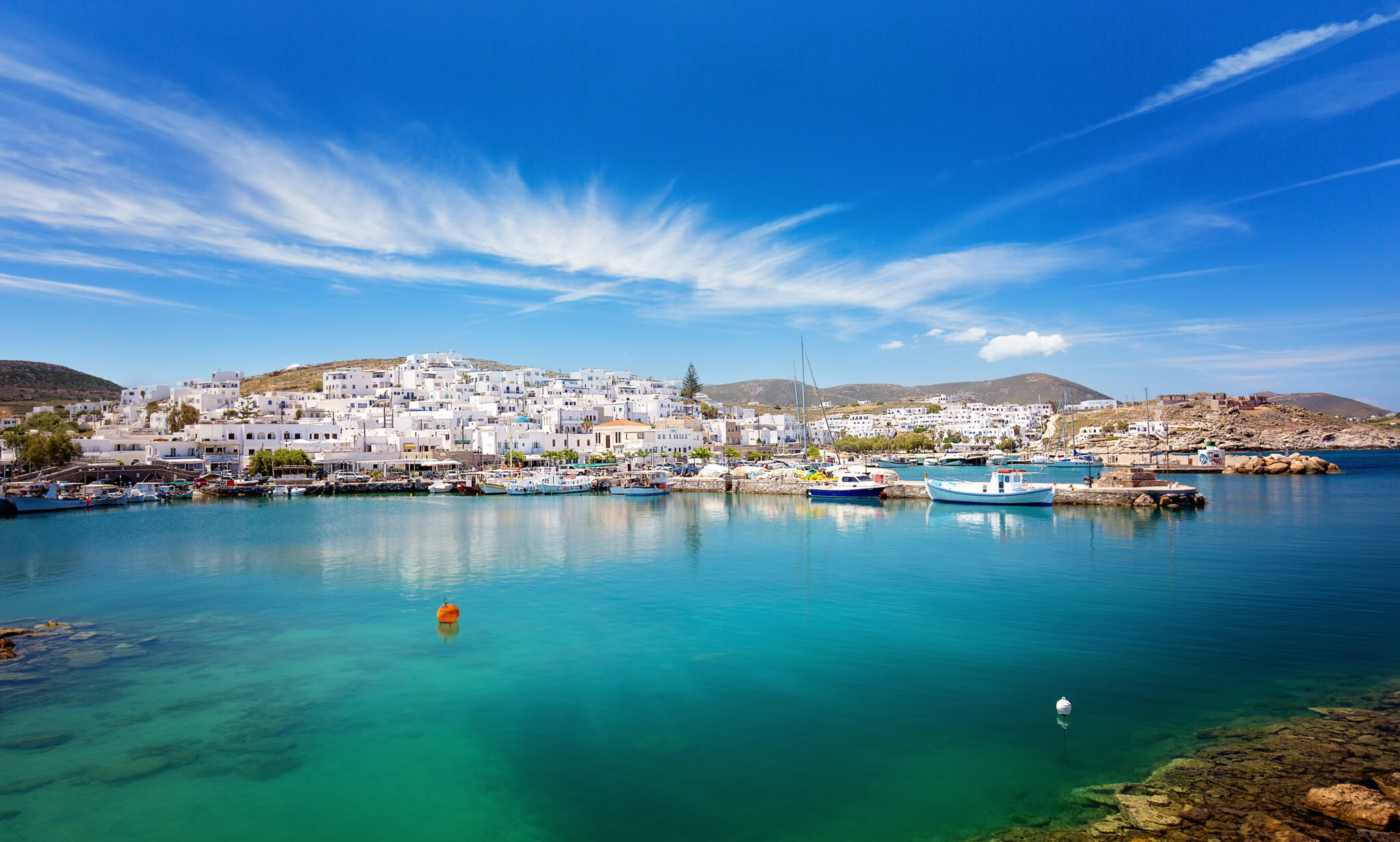
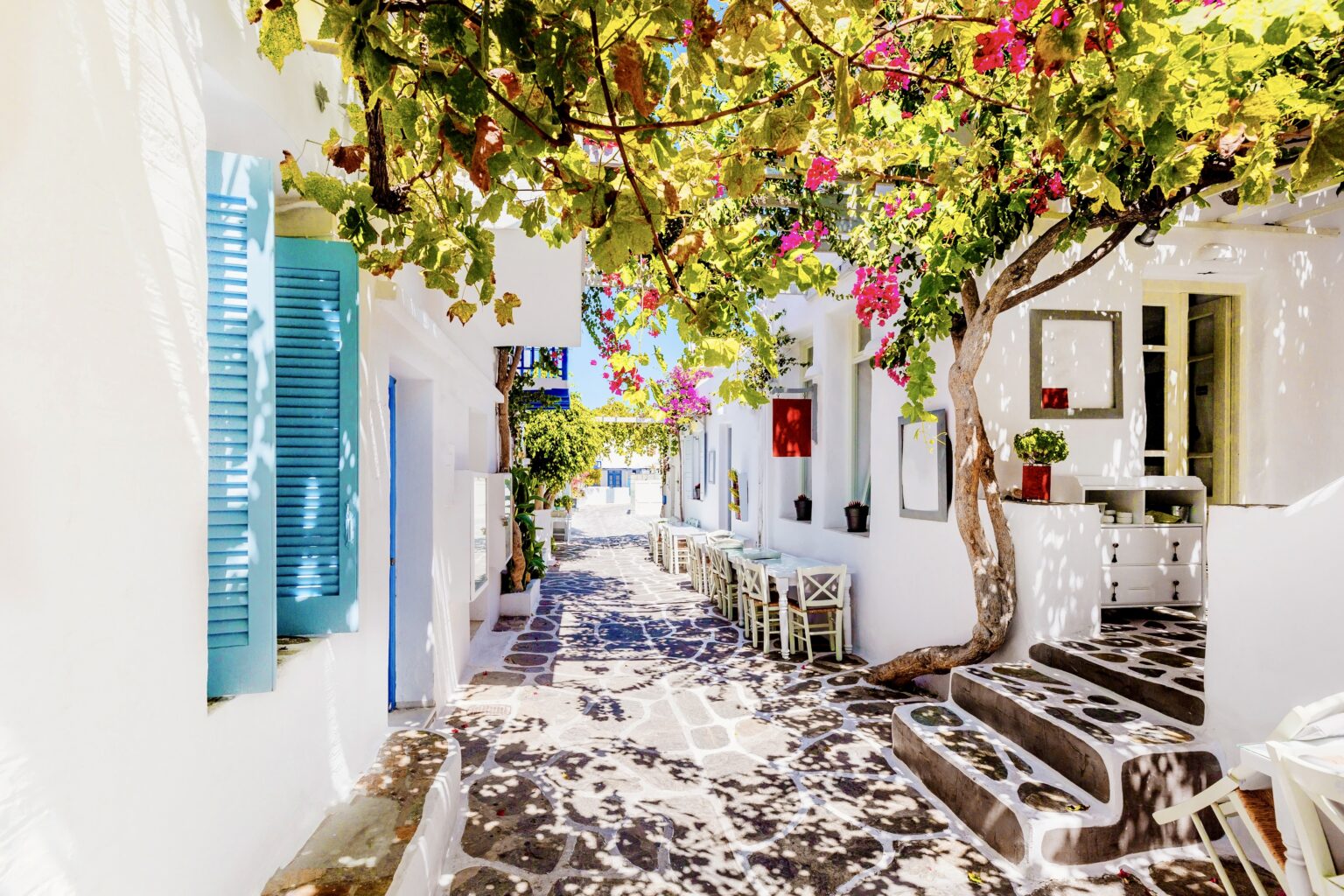
With a gentle and fertile landscape that rolls out from the central peak of Profitis Elias to sand-strewn shores, Paros is loved for its picture postcard fishing harbors, atmospheric inland villages, beautiful beaches, blue domed churches and a lively nightlife. It’s not by chance that the many visitors who are tired by the mere thought of visiting packed and highly busy Mykonos and Santroni now prefer Paros. Add the delicious local food and wine and some of the best water sport conditions in the Mediterranean, and it is easy to see why Paros attracts such a varied crowd. A focal point of the ferry network, many people stop here on their way to somewhere else, enjoying the beaches and the nightlife of Parikia and chic nearby Naoussa.
A. Highlights
Panagia Ekatontapiliani
A historic church complex, Panagia Ekatontapiliani, the Church with a Hundred Doors, is the earliest remaining proto-Byzantine church in Greece and one of the oldest unaltered churches in the world. It is a well known pilgrimage church of the Aegean, second only to the Megalochari in Tinos. Legend has it that 99 doors have been found in the church and the 100th will be discovered when Constantinople comes under Greek rule again. The Byzantine Museum of Paros is found within the complex with rare icons from the 17th and 18th centuries alongside other ecclesiastical items and valuable relics. A 14th century icon of the Virgin is carried in procession on her feast day, August 15th, the Dormition, while at Easter thousands of rose petals are dropped from the dome on the congregation.
Archaeological Museum of Paros
Housing findings from Paros, Antiparos and Despotiko, the Archaeological Museum is split over two rooms and an atrium in Parikia. The first room contains Archaic and Classical sculptures, while the second room showcases pottery, sculptures and small finds from the Neolithic to the Roman era, and the courtyard has a Roman mosaic floor. Highlights include the Gorgon of Paros, a marble mermaid monster from the 6th century BC, the Nike of Paros, a statue of the goddess of Victory from 470 BC without a head, arms or wings, and the Fat Lady of Saliagos, the oldest known Cycladic figure.
Sanctuaries of Asklepios and Pythian Apollo
On the road to Aliki outside Agia Anna are sites dedicated to Asklepios and Pythian Apollo. Only the foundations of the temple to Apollo remain but the Sanctuary of Asklepios is in better condition. Built in the 4th century BC near to a spring which was used in the worship rites, it is a marble building with a central altar, two semi-circular platforms and two marble cisterns. Asklepios was the god of healing and the infirm would gather at the temple in search of a cure. An impressive Kouros was found nearby and is now part of the Louvre museum collection.
The Castles
The Venetian Castle of Naousa is a medieval fortress that was part of a settlement that stretched around the port. The castle was built by the Venetians in the late 13th century and belonged to the Sommaripa dynasty, a French noble family. The Castle of Parikia (Frangokastelo) is situated on Agios Konstantinos hill and was built in approximately 1260 by the Venetians – who used materials from the acropolis and other ancient temples on the island – when Paros was under the administrative control of the Duchy of the Archipelago, also known as the Duchy of Naxos.
Ancient Marble Quarries
Paros is backed by an extensive marble history, which began in the Early Cycladic period and has continued to the present. The quality of Paros’ marble was renowned as a result of its clarity and transparency, light penetrating as deep as seven centimetres. Some of the world’s most celebrated statues have been sculpted using marble from Paros, including the Aphrodite of Milos, better known as the Venus de Milo; Hermes of Praxiteles, also known as Hermes and the Infant Dionysus; the Kore sculptures of the Acropolis; the Nike of Samothrace; as well as renowned temples, among them the Temple of Apollo at Delphi, and the Temple of Zeus at Olympia.
B. Culture
In summer, a week never seems to pass in Paros without some celebration or feast day. The Pirate Festival marks the anniversary of a raid on Naoussa by Barbarossa in 1537. The 23rd of August fiesta involves the young men of the island trying to capture the womenfolk and it is a raucous celebration of dancing, feasting, fireworks and drinking. The feast of the Panagia on Paros is synonymous with the Ekatontapiliani church as thousands of pilgrims gather for a liturgy followed by a procession of an icon through the streets of Parikia and a nightlong celebration of traditional music and dance.
Many artists have made the island their home, drawn by its light and natural beauty, and Paros has a vibrant art scene with a number of galleries and public spaces used for exhibitions. Paros Park hosts a summer programme of events with concerts in the amphitheatre and films under the stars at Cine Enastron.
C. Villages
Unlike the smaller Cycladic islands with a tiny Hora and a port, Paros is blessed with a handful of countryside villages, known for their traditional atmosphere, whitewashed buildings, winding paved streets, and pretty churches. Away from bustling Parikia and Naoussa are communities with streets too narrow for cars to pass, and beautifully kept houses with geranium-filled courtyards and cats sleeping in the sun. One great way to discover the beautiful, less conspicuous zones is to walk the medieval flagstone path that once linked the two sides of the island.
Starting in Marmara, (which means marble), head west to Prodromos where the Byzantine Road begins, a path thought to have been built around 1000 AD. A fortified farming settlement with distinctive walls made up of the outer houses, the village is full of narrow, arched walkways and bougainvillea-filled pedestrianized streets that lead to the Church of Agios Ioannis with its distinctive bell tower.
Nearby Marpissa is built on the hill of Kefalos with no less than 19 churches and nine squares. Beautifully kept, it was mostly built in the 16th and 17th century and its cobbled streets are a delight to wander. The central square features three characteristic windmills, while a path leads to the top of the hill and the monastery of Agios Antonios and the ruins of an ancient castle. The views across the eastern side of the island over the Aegean to Naxos are unparalleled. Five kilometres on from Prodromos is the Ottoman capital of Paros, Lefkes. Built amphitheatrically into a green valley, it is perhaps the most beautiful of the mountain villages on the island.
D. Beaches
Paros has a beach for all tastes; quiet, sandy coves with glistening waters, long sweeps of dramatic rock formations, breezy shores perfect for watersport lovers, and even a natural exfoliating mud beach for a healing spa day. Many beaches are organized as it is a busy island popular with a wide spectrum of visitors but from families with young children through partygoers, surf worshippers, and naturists, the island is big enough to cater for all. With over forty shorelines to choose from, the island benefits from a coastal road which encircles the island providing easy access to even the remotest beaches.
The waters of Paros are magical. The island offers beaches covering all preferences, from serviced beaches with loud beach bars and water sports to family beaches and detached beaches for absolute serenity. Kolybithres is the island’s most renowned beach, and one of Paros’ most beautiful and unique seaside spots. Pounta is a lovely beach, medium in size, and mostly popular among windsurfers and kitesurfers drawn by suitable winds in the area. Hrysi Akti is a serviced beach with soft sand and a variety of water sports services. Monastiri, a small, elegant bay, is sheltered from windy weather. The beach is serviced and is preferred by families attracted by its shallow and clean waters. Laggeri beach can be accessed by boat or on foot. It offers incredible crystal-clear waters, tamarisks and quietness. Opt for this beach if you prefer non-serviced beaches. And Santa Maria, with transparent waters and a golden sandy beach, has several beach bars, sun and plenty of water sports action.
Read more about Paros’ beaches.
E. Food
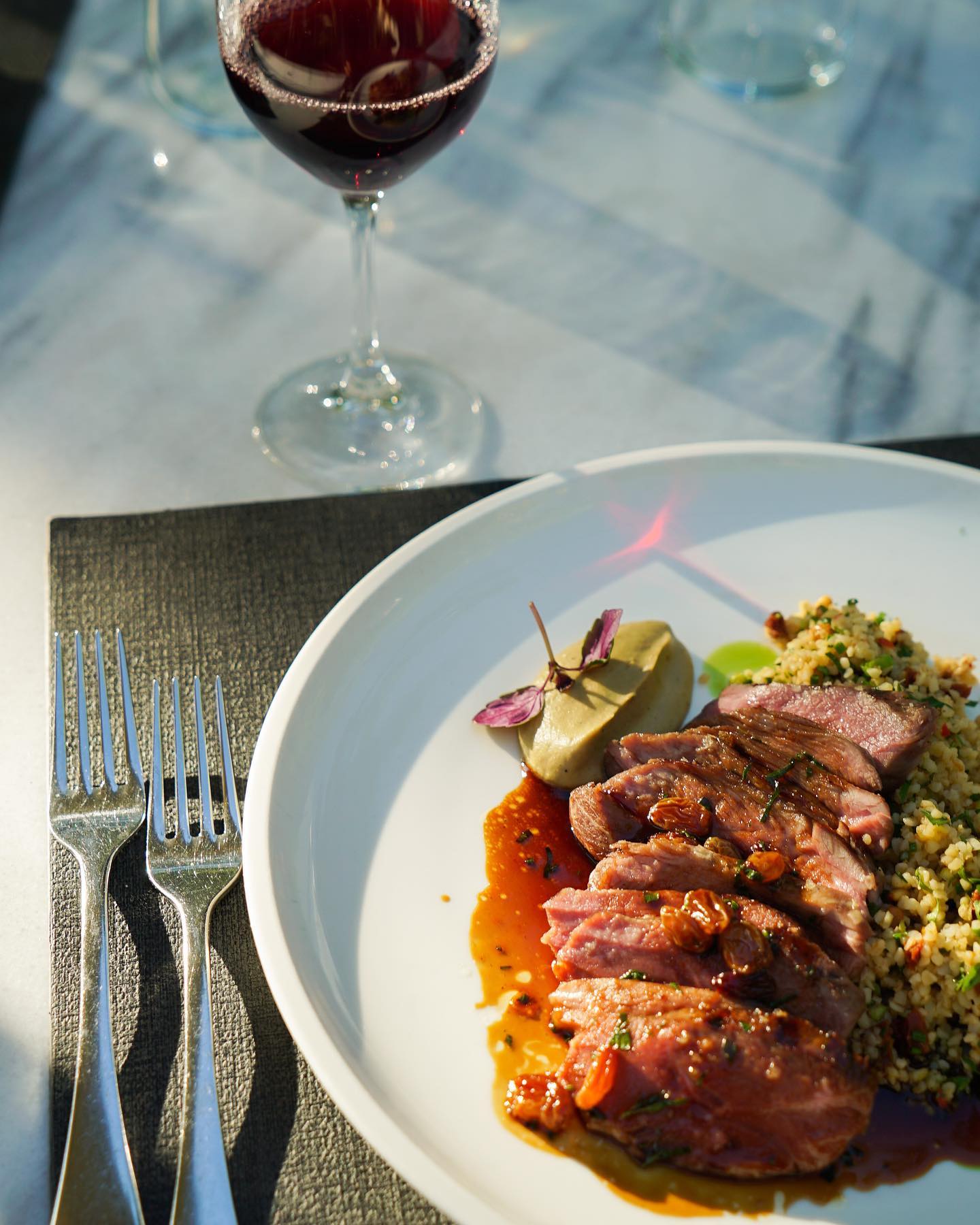
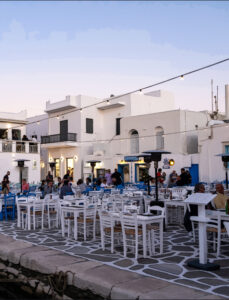
‘Gouna’, souma, xynomyzithra; the triptych of Paros’ culinary essence. Around this core, in some coffee shops, restaurants and taverns, mostly in the south part of the island, you’ll find traditional delicacies like artichokes with broad beans in lemon and olive oil sauce, escargots with garlic sauce, meatballs with yellow pumpkin. And you’ll also discover many cheeses; apart from the great xinomyzithra, they make amazing graviera, touloumotiri, krasotiri, that you should make sure to ask for.
And, of course, you’ll eat fish. A lot of fresh fish at the taverns and the restaurants opened and run by the sons of fishermen, many of whom still have their own caiques and source their own fish. And you’ll have octopus, that you’ll see drying in the sun all over the island. The great popularity of Paros, both within and outside Greece, has brought along the respective crowds, and as a result you’ll find fish carpaccio, ceviche and tartare side by side with the tomato and courgette balls (just like some years ago, you found sushi everywhere, together with the traditional dishes). Read more about Paros’ traditional gastronomy.
However, the traditional local cuisine is so powerful that it welcomes new, foreign, flavours, and effortlessly mixes them with its own, and nods to foodies offering them an aromatic wild greens pie next to crab tartare. One thing is certain: in Paros, you’ll eat and drink well, and you’ll become privy to a wide variety of fish- wild greens- and vegetable-based delicacies that allow ceviche, tartare and carpaccio a place next to them.
Depending on the mood, you can select between a coffee shop that’s been around for decades, a family-run fish tavern with its own caique, a well-kept restaurant that serves modern Greek food, or even a restaurant with fusion cuisine that favours local products from Paros and Greece. The culinary tour of the island starts in Parikia, goes through Naoussa, then through Lefkes, and down south. Read about where to eat in Paros.
D. Nightlife
Of all the Cyclades, the island Paros best combines old-school tradition with contemporary entertainment. This destination’s picturesque little tavernas and quiet beaches harmoniously coexist with beach bars and vibrant nightlife activity. Parikia, the island’s capital and main port, as well as Naousa, are the main nightlife areas of Paros, both offering dozens of after-dinner options. By contrast, the pace of life at a slower rhythm, and Paros’ genuine traditions, are far more apparent in the villages of Marpissa, Ampelas and Dryos.
Read more about Paros’ nightlife.
03
Antiparos
Antiparos has come a long way from being an Aegean after thought, to becoming a sought-after destination for the wealthy and famous. Despite its transformation into a premium destination, it has managed to retain its mystique, no thanks to its stunning beaches, which offer a varied mixture for visitors. According to myth, Poseidon threw down his trident striking a piece of land into three pieces. The largest of the three, Naxos, he gave to his wife Amphitrite, the second he adorned with a beautiful coastline, Paros, and the third he filled with verdant fields, Antiparos. More prosaically, a causeway once crossed the narrow strait between Paros and Antiparos but the island was severed from its larger sibling as a result of an earthquake around 550 BC.
A. Highlights
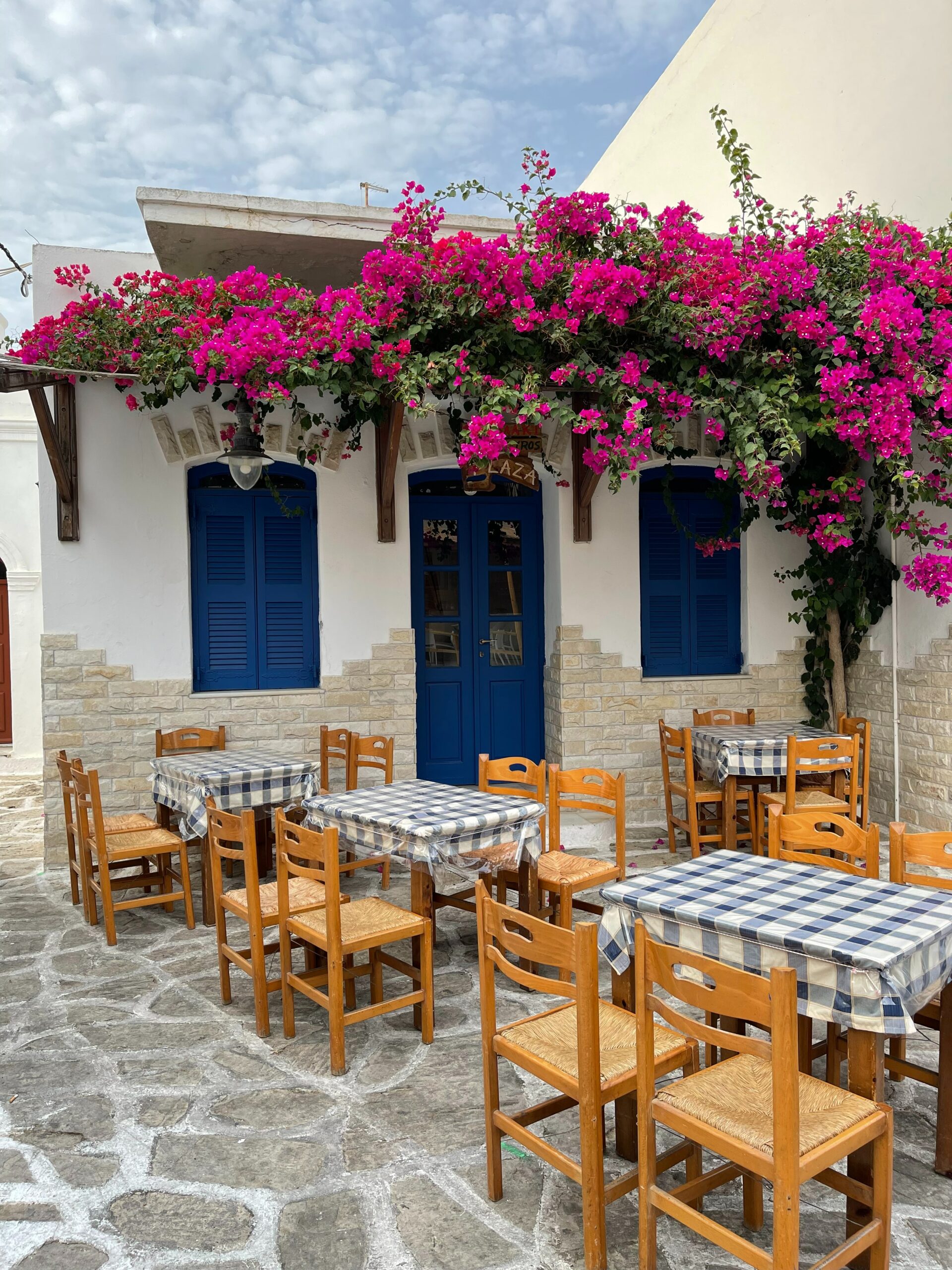
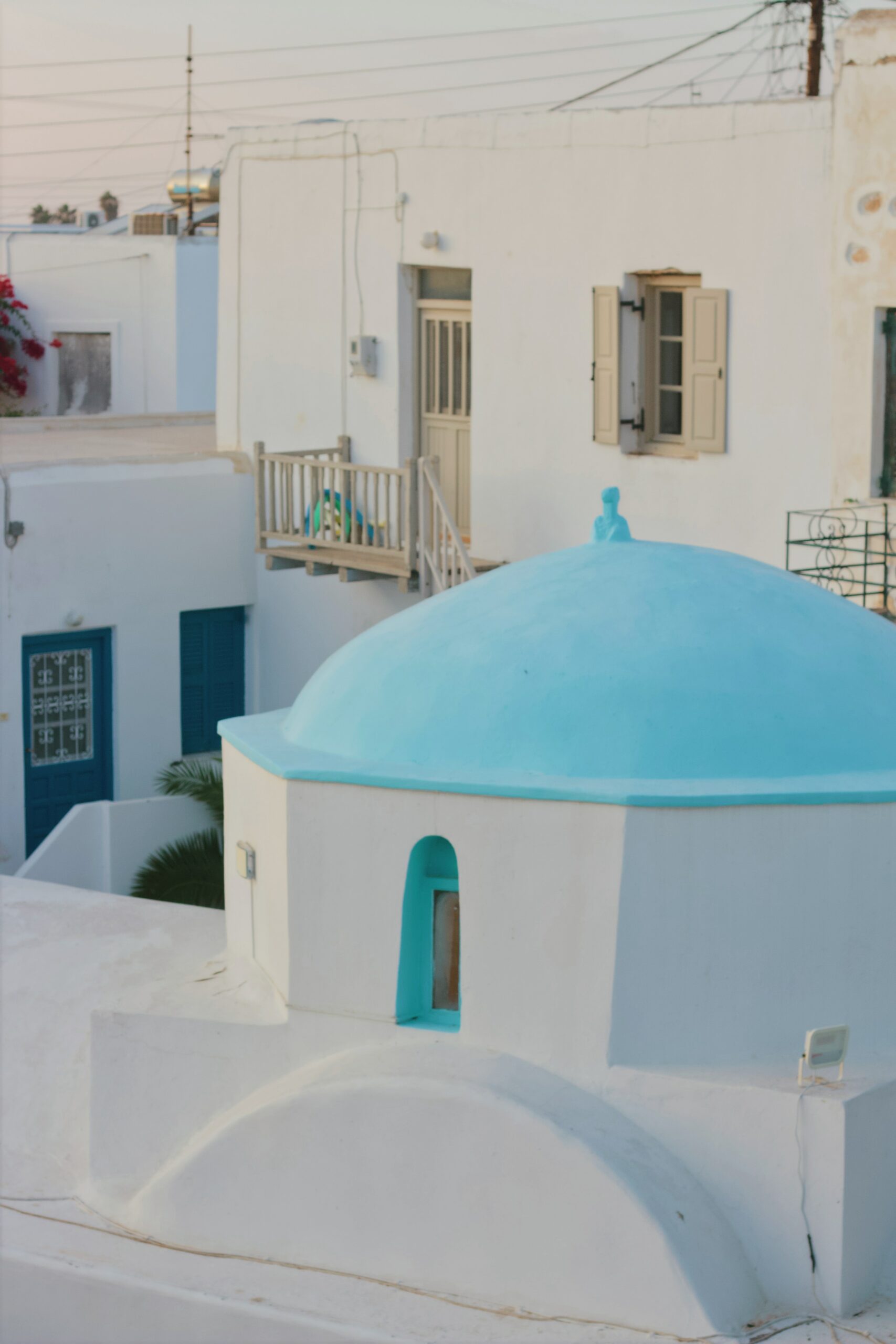
The Main Square
This is where all the social action takes place. To the right of the main town’s square are houses and the wall of the 15th century Kastro, while at the other end of quay from the ferry dock a path leads to a beautiful sandy beach where you can wade across to Diplo, an islet home to sheep and goats. Taverns and street vendors, grocery stores and dive shops, a playground and a jewellery shop; everything is located on the large pedestrian street that starts from the port and ends at the square with the cafes, bars and the church. But the island, which has often served as the stage for several -mainly Greek- films, has become a hot destination in the last decade with boutique guesthouses, trendy fashion stores, sophisticated restaurants and numerous A’List celebs. If you find yourself in Antiparos, a two-day stay is all you need to get a good taste of this little paradise of an island.
The Saltbitten Adventuring
For such a small island, Antiparos packs a punch for things to do. There are plenty of wonderful beaches to relax at. Watersport enthusiasts love it for the reliable winds and calm waters and the shores are ideal for wind and kite surfing. A couple of beaches have kayaks and SUPs to rent and they are an enjoyable way to explore the coastline. It is a paradise for sailing, attracting yachts from all over the Aegean who enjoy navigating the clear coastal waters around the island, dropping anchor at the successive caves of Fokospilies on the southern shoreline. The clear, unspoilt seas around Antiparos are ideal for exploring underwater. Diving clubs will help you navigate the underwater canyons, reefs and shipwrecks that litter the coastline. Barracuda point, Bubble reef, and the cave at the islet of Paderonisi are just some of the sites that you can visit and the experienced dive personnel cater for all abilities.
Despotiko Island
A stone’s throw from Agios Georgios on the southwest coast is the islet of Despotiko. Geographically, it, rather than Delos, is the literal centre of the Cyclades, and on a clear day looking clockwise it is possible to see the surrounding islands of Antiparos, Syros, Serifos, Sifnos, Kimolos, Folegandros, Sikinos and Ios. Presently uninhabited, in ancient times it played a strategic role as a safe anchorage and there are the remains of an important late Archaic sanctuary to Apollo, a Doric temple with an ornate facade.
Under the name Prepesinthus, Despotiko was written about by Strabo and Pliny the Elder. Blessed with a beautiful coastline, the island is visited by boats that run from Agios Georgios and from Paros, and most stop at the lovely Livadi beach. Neighbouring islet Stroggylo, similarily uninhabited, has a magnificent sandy bay with beautiful clear turquoise waters, while Tsimintiri, home to a family of inquisitive goats, can be swum to from Agios Georgios.
Cave of Antiparos
In the 19th century the most famous sight in the Aegean was the Cave of Antiparos, even inspiring the story of “The Swiss Family Robinson.” The oldest known cave in Greece, it is to the southeast of Antiparos on Mt.Ai Gianni, and the oldest stalagmites and stalactites are thought to be over 45 million years old.
This wonder of the natural world was known in ancient times but was rediscovered by a French ambassador in the 16th century and myths and legends have been told about it ever since. The walls are covered in graffiti; look out for the autographs of Lord Byron and King Otto. There are exactly 411 steps down to explore the 85-meter depth. At the entrance to cave is the Church of Agios Ioannis Spiliotis, built in 1774 and the views from the top are sublime with the Aegean spreading across to Paros. There is an audio tour, and the cave is serviced by bus. The ticket to the Cave of Antiparos includes free entry to the Historical and Folklore Museum.
Church of Profitis Ilias
On the highest peak of the island at an altitude of 308 meters. Built in 1937, the materials to construct the church were transferred to the summit by Ioannis Patelis, a local miner, and his donkey. A 4 kilometer hike from Agios Georgios, the panoramic views from the church over the blue Aegean and to the neighbouring islands is worth the walk.
Venetian Castle
Walking from the port into the pedestrianised alleyways of Antiparos town lined with whitewashed houses, shops and restaurants, an arched gateway to the ancient centre known as Kamara leads to the Venetian Kastro, or castle, of Antiparos. Commissioned in 1440 on the orders of Italian Leonardo Loredano, it was built to house and protect a colony of farmers shipped in to repopulate the island. Seemingly a typical Cycladic defensive fortress, it is unique in not being built on a impregnable hill or hidden away inland as it is on a flat plain in full view of the sea, and on three known occasions (1537, 1675, and 1794) the Kastro fell, and the inhabitants were massacred.
Walk the cobbled streets of the village where islanders still live in homes built on top of each other in one continuous block within the stone walls where the enclosed atmosphere still remains and wonder at a life little unchanged for hundreds of years.
B. Beaches
There is some debate among locals on the island about which beach is the most beautiful in Antiparos – Agios Sostis or Faneromeni. Both are undoubtedly beautiful, and it’s up to individual preference which one you might prefer. Whether you’re looking for a serviced beach with a great beach bar, a secluded spot for a quiet day by the water, or a nudist-friendly area, Antiparos has something to suit everyone’s preferences. Its evolution into a premier destination is a testament to the island’s natural beauty and resources, and it’s no wonder it now attracts such a high-profile crowd.
Camping beach is a truly legendary in the Cyclades, renowned for its popularity among alternative travelers and nudists. Soros beach s is a must-visit destination for anyone looking to spend a day at the beach. With its wide, sandy shores and deep waters, it’s a great spot for swimming and soaking up the sun. Psaraliki beach is recommended for families with small children. Its calm and shallow waters, as well as its protection from the wind. Read more about Antiparos’ beaches.
C. Food
The island’s seafood is plentiful, serving as delicious appetizers for raki and ouzo. Popular favorites include grilled octopus, various preparations of cuttlefish and squid, along with sea urchin salad and shellfish. Additionally, fish options and sun-dried whitebait, lobster with oil and lemon, and kakavia fish soup in a delicate broth are irresistibly tasty.
Wild herbs, traditional breads, cheeses and fresh fish epitomize Antiparos’ flavorful cuisine. The island’s low slopes and rocks are populated with thyme, sage, rosemary, and pink-flowered throubi. Wild greens are boiled for salads – try the ‘provatses’ and wild garlic. Traditionally, delicious samphire and edible sea rocket were gathered from the shores and sometimes still appear in menus today. Goats are primarily raised, and the majority of cheeses produced are derived from goat’s milk. Try the local Kefalotyri, ladotyri and mizithra, present in many traditional dishes, from salads to pies. Traditionally favored sweets to taste include fried ‘diples’ (crispy dough drizzled in honey and walnuts) as well as ‘anevates tiganites’, pancakes that are fried, drizzled with honey, and sprinkled with sesame seeds and nuts.



